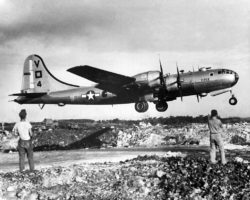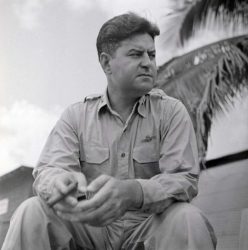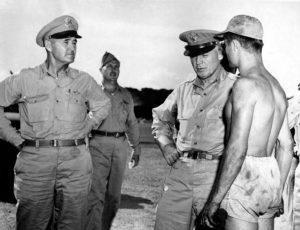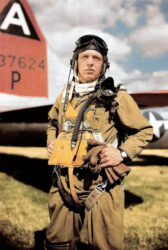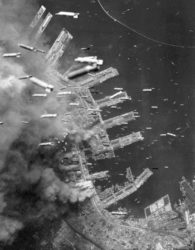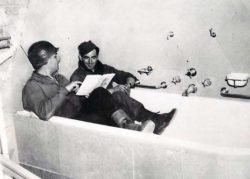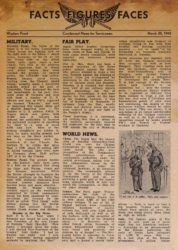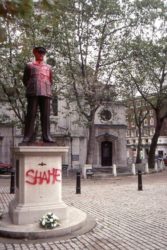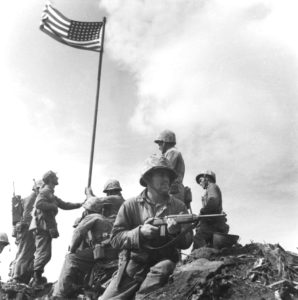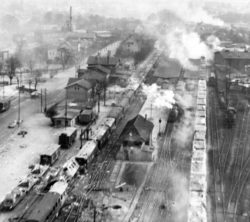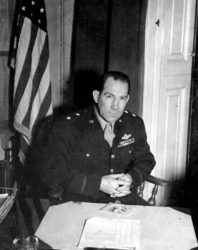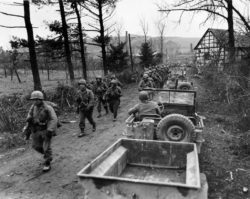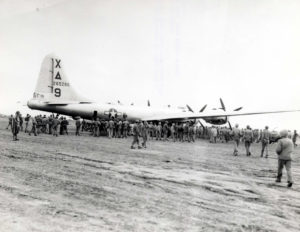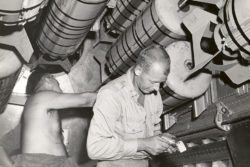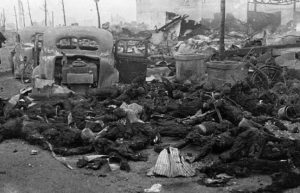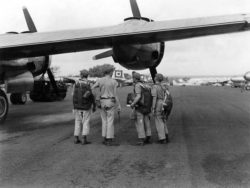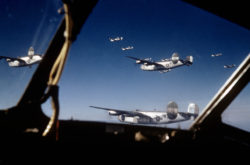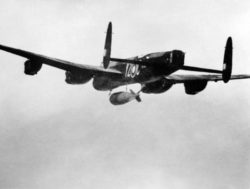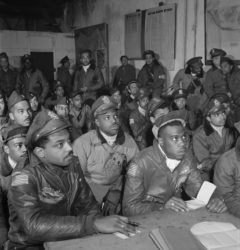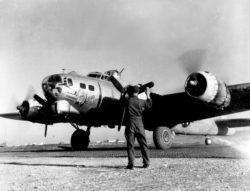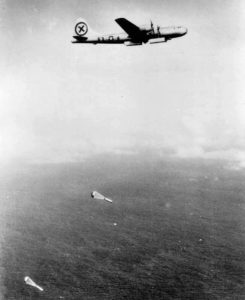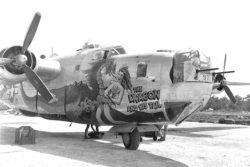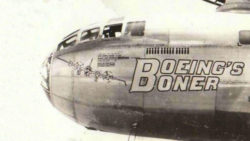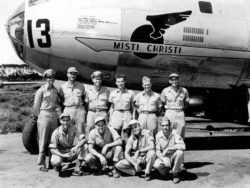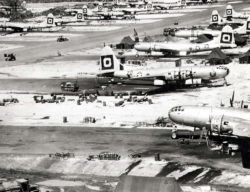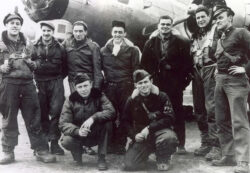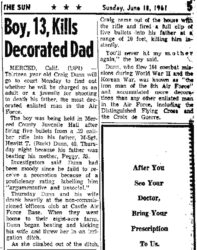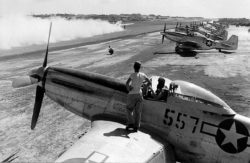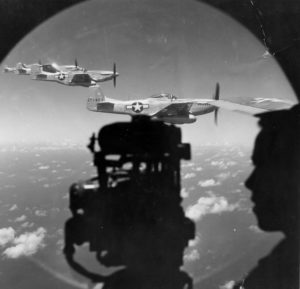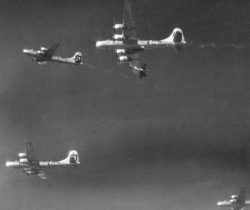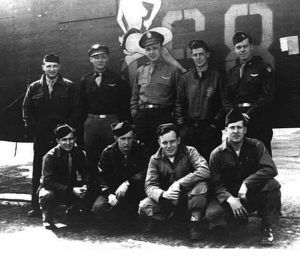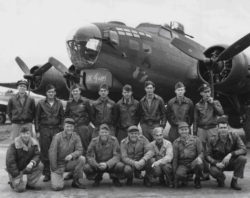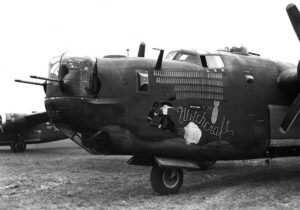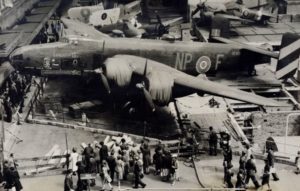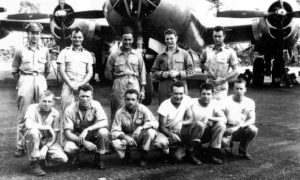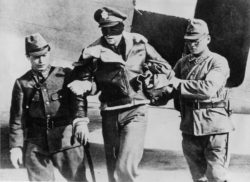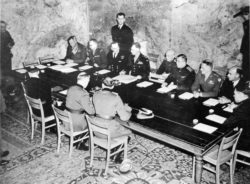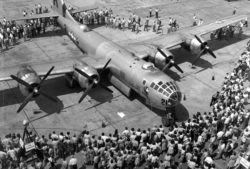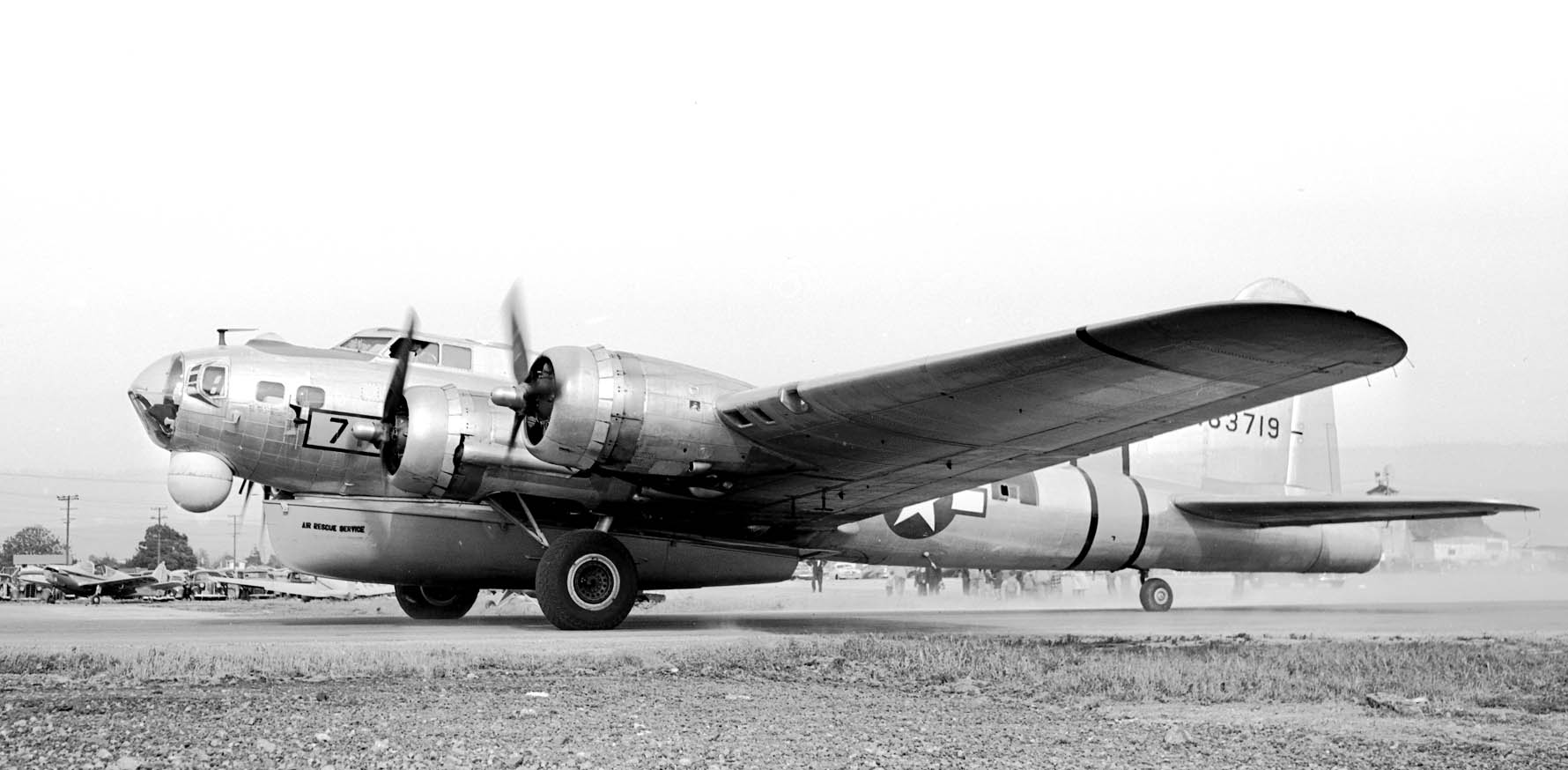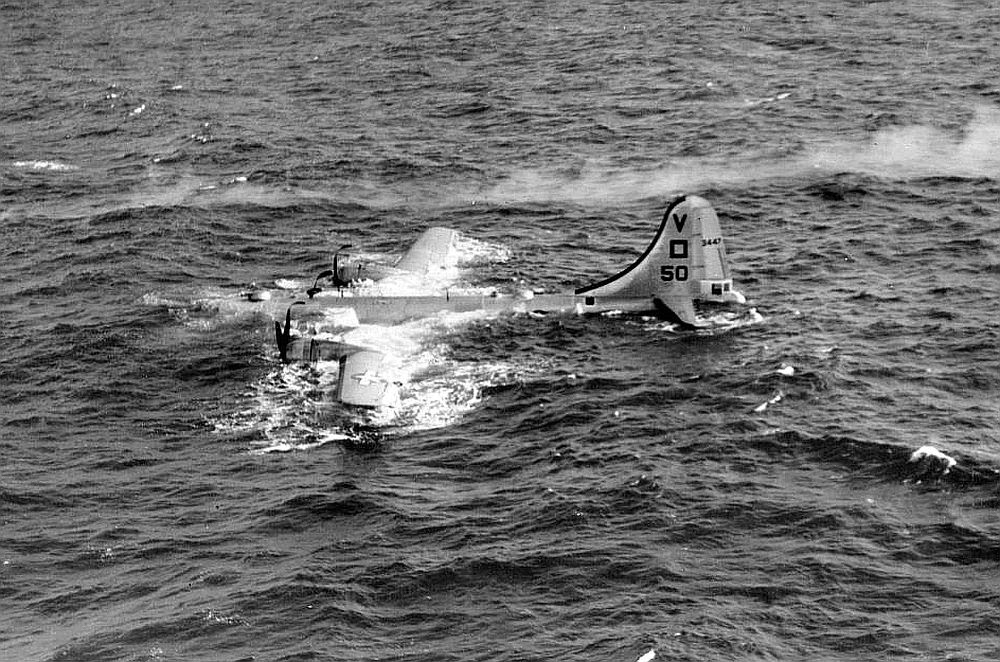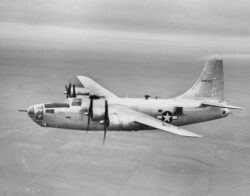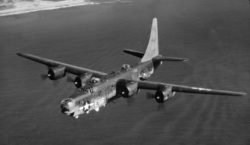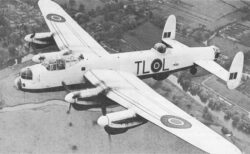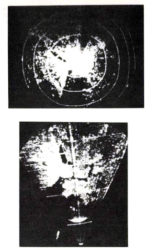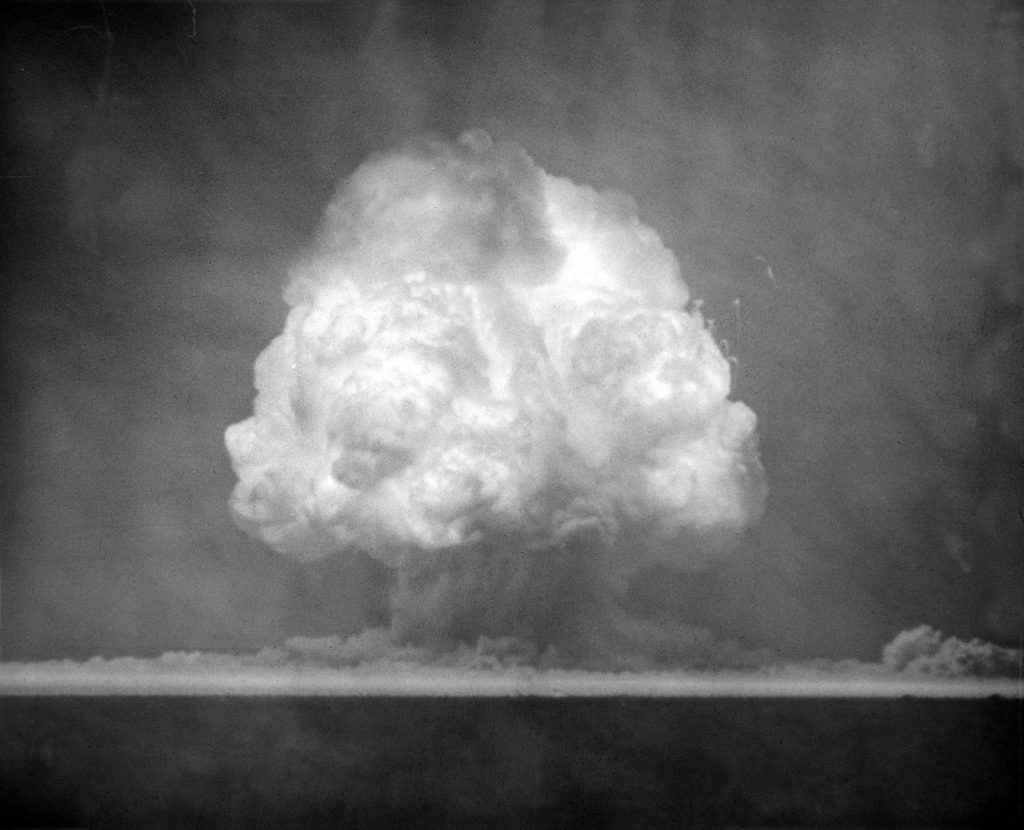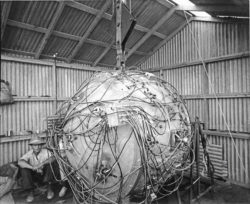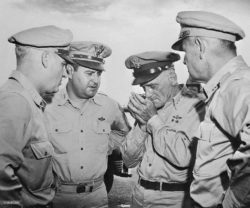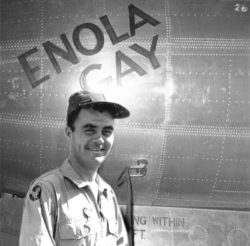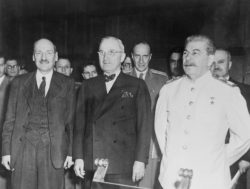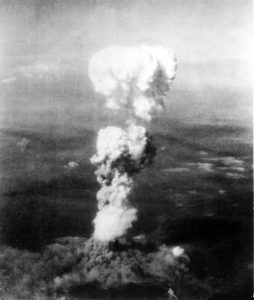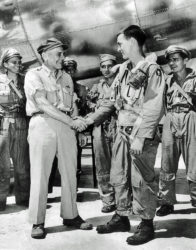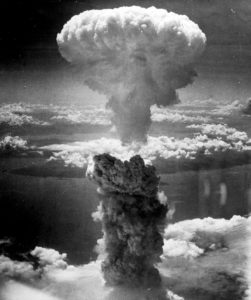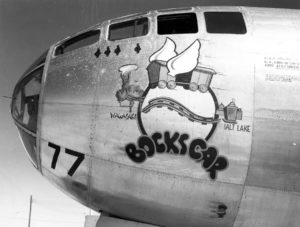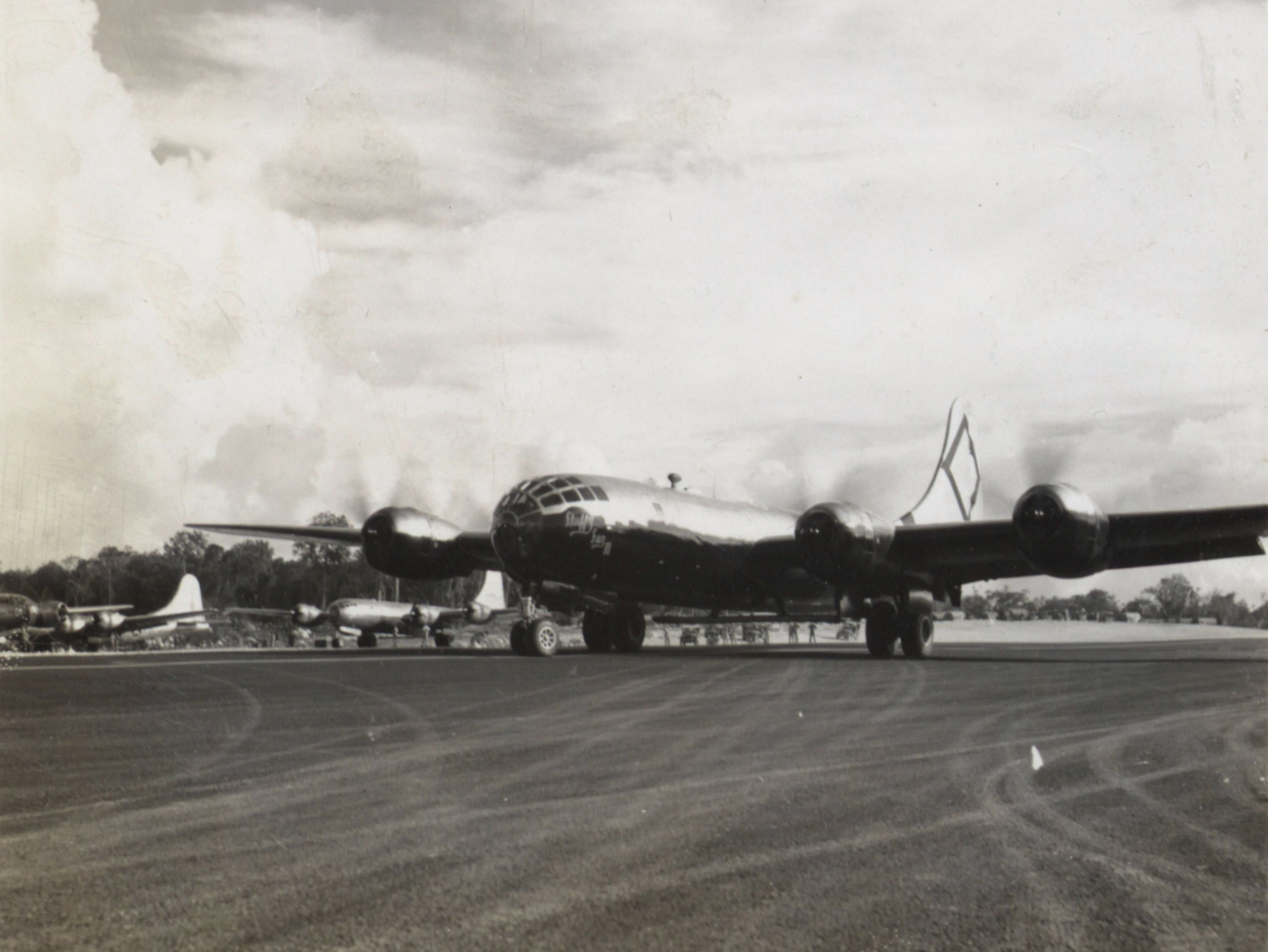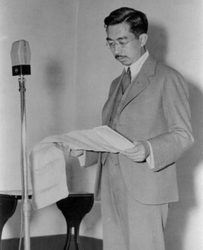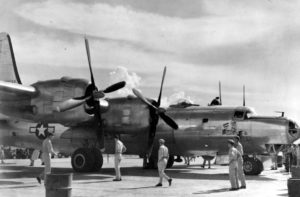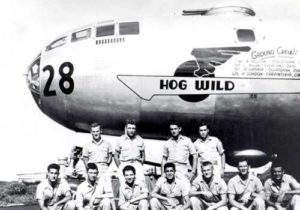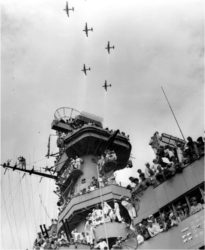Timeline of Strategic Aviation
Second World War
1945
6 JANUARY 1945
CS USAAF LTG Lauris Norstad arrives on Guam to officially relieve CG XXI BC (20AF) MG Haywood S. Hansell, Jr. of command. Hansell is to be replaced by CG XX BC (20AF) MG Curtis E. LeMay, who arrives some two weeks later. Despite a vigorous written protest, Hansell’s rather-cold dismissal is assuaged only by an offer to remain as LeMay’s XO. The offer is refused. LeMay is bluntly told to achieve results or face his predecessor’s fate. BG Roger M. Ramey assumes command of XX BC until it is transferred to the Marianas Islands, after which the two commands will be formally dissolved. XX BC flies their last mission in the CBI Theater on 29 March.
Hansell’s insistence at 8AF-style tactics with the Boeing B-29 had not gone well. The winds of the Pacific jet stream hampered bombing accuracy and caused undue strain on the B-29s’ already over-taxed engines. While Hansell implemented several programs to lighten the weight of the bombers, he faced criticism from above and below for not making more drastic efforts. The truth was that, as the single most expensive US investment of the war, the B-29 program needed results to justify its cost. Thus far, the 20AF had little to show for its heavy losses – the fact that these losses were overwhelmingly due to operational causes, rather than combat, was inexcusable.
9 January 1945
CG USAAF GA Henry H. Arnold suffers his fourth heart attack of the war. This heart attack is rather serious in comparison to his previous three and steps are immediately taken to lighten Arnold’s workload – which up to this point has been considerable.
Though strategically sound, Arnold’s decision to command Boeing B-29 operations directly from Washington, DC proved problematic. Arnold was characteristically impatient with CG XXI BC MG Haywood S. Hansell, Jr., culminating in Hansell’s relief on 6 January. Hansell was a model officer and a major figure in the prewar planning, as such, his relief and subsequent protests were not well handled. Likewise, XO 20AF LTG Millard F. Harmon, Jr. - Arnold’s proxy in the field - is by this time revealed as a poor choice. Also serving as the senior airman under CINC POA FADM Chester W. Nimitz, Harmon's natural conflict-of-interest resulted in him regularly butting heads with subordinates (which certainly did not help Hansell's situation). When Harmon disappears on 26 February en route to Washington, DC , the tragedy is quickly taken advantage of. Arnold’s XO, LTG Barney M. Giles, takes Harmon’s place on 4 March, and the ever-capable LTG Ira C. Eaker, CG MAAF, is named Arnold’s new deputy commander on 30 April.
Arnold is placed under nine days of supervised recovery at the Biltmore Hotel in Coral Gables, FL. Upon recovery, Arnold undergoes an inspection trip of B-29 operations in the Pacific. MG Curtis E. LeMay (Hansell’s replacement) drastically alters 20AF operations by this point, the success of which has a notable effect on Arnold’s health.
3 February 1945
As per Operation THUNDERCLAP, the US 8AF launches 1,003 Boeing B-17s and 434 Consolidated B-24s, escorted by 44 Republic P-47s and 904 North American P-51s, against the railyards of Berlin and the BRABAG refineries of Magdeburg. The 1AD is led by S-3 91BG LTC Marvin D. Lord aboard "R-Roger" (42-97632) and the 3AD by CO 418BS MAJ Robert Rosenthal aboard "J-Jig" (44-8379, 100BG). While the 1AD drops visually, the 3AD is forced to drop using H2X. In accordance with previously established policy, the B-24s of the 2AD bomb the Magdeburg refineries rather than overfly Berlin.
THUNDERCLAP originated with the failure of Operation CROSSBOW – the bombing of V-weapon launch sites – the previous year. While British PM the Rt. Hon. Winston L. Spencer-Churchill (CP) pushed for massive reprisal operations, CAS MRAF Sir Charles F. A. Portal argued to delay such operations until such time as to have a decisive effect on the war. THUNDERCLAP was officially approved on 3 August 1944. With the Soviet Union renewing its offensive on 12 January 1945 and the Yalta Conference (ARGONAUT) beginning on 4 February, THUNDERCLAP is now renewed as a means of supporting the Soviet advance.
Despite using railyards as fig leaf, THUNDERCLAP is in actuality the first US 8AF strike to actively target urban areas with a psychological goal rather than an economic/logistical one. CG 8AF LTG Jimmy H. Doolittle bitterly contests the operation but is rebuked by CG USSTAF GEN Carl A. Spaatz, as the operation is fully endorsed by CG SHAEF GA Dwight D. Eisenhower. No German fighter interceptions take place, and the government quarter of Berlin is heavily damaged. While THUNDERCLAP is unsuccessful in generating a political collapse, follow-ups on eastern German cities continue throughout the next month, with the 1,329-strong attack of 18 March being the largest strike on the German capital of the war. (2,893 killed)
| Bombers Launched: | 1,437 |
| Bombers Effective: | 1,370 |
| Fighters Launched: | 948 |
| Fighters Effective: | 885 |
| Bombers MIA: | 27 |
| Bombers DBR: | 7 |
| Bombers Abort: | 67 |
| Fighters MIA: | 8 |
| Fighters DBR: | 2 |
| Fighters Abort: | 63 |
| Abort Rate: | 5% |
| Loss Rate: | 2% |
| Aircraft Type | Serial No. | Name | Code | Unit | MACR |
| Boeing B-17G-35-BO | 42-32085 | Yankee Belle | DF-H | 324BS/91BG | 12233 |
| Boeing B-17G-20-VE | 42-97632 | DF-R | 324BS/91BG | 12232 |
| Boeing B-17G-85-BO | 42-38364 | Demobilizer | NV-L | 325BS/92BG | 12031 |
| Boeing B-17G-60-BO | 42-102951 | BG-Q | 334BS/95BG | 12048 |
| Boeing B-17G-100-BO | 43-38899 | ET-N | 336BS/95BG | 12156 |
| Boeing B-17G-45-DL | 44-6170 | Sittin' Pretty | MZ-M | 413BS/96BG | 12155 |
| Boeing B-17G-40-DL | 44-6092 | Dixie's Delight | LN-F | 350BS/100BG | 12044 |
| Boeing B-17G-60-BO | 42-102958 | LN-G | 350BS/100BG | 12047 |
| Boeing B-17G-50-DL | 44-6500 | LN-U | 350BS/100BG | 12045 |
| Boeing B-17G-60-VE | 44-8379 | EP-J | 351BS/100BG | 12046 |
| Boeing B-17G-55-BO | 42-102555 | KY-F | 366BS/305BG | 15679 |
| Boeing B-17G-55-BO | 42-102547 | Rose Of York | GY-F | 367BS/306BG | 12283 |
| Boeing B-17G-85-BO | 42-38407 | GY-P | 367BS/306BG | 12218 |
| Boeing B-17G-25-VE | 42-97658 | Jones Family | GY-S | 367BS/306BG | 12495 |
| Boeing B-17G-25-VE | 42-97678 | Birmingham Jewel | LF-J | 526BS/379BG | 12217 |
| Boeing B-17G-60-BO | 42-102873 | Joker II | VE-H | 532BS/381BG | 12096 |
| Boeing B-17G-100-BO | 43-38898 | Blind Date | GD-G | 534BS/381BG | 12295 |
| Boeing B-17G-50-BO | 42-102501 | Challenger | BK-H | 546BS/384BG | 15315 |
| Boeing B-17G-40-VE | 42-97960 | SO-M | 547BS/384BG | 12153 |
| Boeing B-17G-45-BO | 42-97387 | Maude An' Maria | K8-H | 602BS/398BG | 12214 |
| Boeing B-17G-95-BO | 43-38697 | N7-M | 603BS/398BG | 12215 |
| Boeing B-17G-85-BO | 43-38358 | Slightly Dangerous | 6K-J | 730BS/452BG | 12496 |
| Boeing B-17G-80-BO | 43-38150 | W8-unk | 849BS/487BG | 12238 |
| Boeing B-17G-80-BO | 43-38242 | G6-unk | 863BS/493BG | 12157 |
| Consolidated B-24J-1-FO | 42-50628 | GO-F | 328BS/93BG | 12231 |
| Consolidated B-24J-1-FO | 42-50551 | Delectable Doris | RR-R | 566BS389BG | 12370 |
| Consolidated B-24H-20-FO | 42-94936 | Li'l Snooks | JU-R | 707BS/446BG | 12243 |
All of this day's losses are due to AAA.
Guy F. Byam, a reporter for the BBC, is killed while accompanying Rose of York (42-102547, 306BG).
The Jones Family (42-97658, 306BG) and Slightly Dangerous (43-38358, 452BG) land in neutral Sweden and are interned.
Maude An' Maria (42-97387) and "M-Mike" (43-38697) of the 398BG are lost after a midair collision.
| Aircraft Type | Serial No. | Pilot | Code | Unit | MACR |
| Republic P-47D-28-RE | 44-19777 | 1LT David M. Magel | UN-M | 63FS/56FG | 12163 |
| North American P-51D-15-NA | 44-15729 | 1LT William B. Senarens | HL-T | 83FS/78FG | 12164 |
| North American P-51D-20-NA | 44-63182 | 1LT Leon M. Grisham | WZ-M | 84FS/78FG | 12166 |
| North American P-51D-15-NA | 44-15746 | 2LT Warren J. Sawall | WZ-N | 84FS/78FG | 12165 |
| North American P-51D-15-NA | 44-15124 | 2LT Frederick H. Powell | PZ-A | 486FS/352FG | 12323 |
| North American P-51D-10-NA | 44-14303 | MAJ Leslie W. Seppala | SX-B | 352FS/353FG | 12169 |
| North American P-51D-5-NA | 44-13586 | 1LT George C. Kouris | C5-T | 364FS/357FG | 12173 |
| North American P-51D-5-NA | 44-13686 | 1LT John J. Allen | 5E-N | 385FS/364FG | 12173 |
4 February 1945
As per Operation MIDDLEMAN, US XXI BC (20AF) launches 112 Boeing B-29s against Kōbe, Japan. Upon the suggestion of CS USAAF LTG Lauris Norstad, a third of the ordnance carried this day are incendiary bombs. Incendiaries proved frightfully effective against mock Japanese dwellings in Dugway, UT and, as a result, Norstad pressured former CG XXI BC, MG Haywood S. Hansell, Jr. to adopt an area-bombing strategy using incendiaries. While Hansell resisted this, his replacement, MG Curtis E. LeMay, witnessed the effectiveness of incendiaries against Asian targets in a strike against Hànkǒu, China on 18 December 1944. As such, LeMay was somewhat more willing to firebomb Japan.
LeMay’s first month of command in the Marianas fared little better than his predecessor. Hansell’s last planned operation, a precision strike against the Kawasaki Kokuki Kogyo (Kawasaki Aircraft Industries) plant of Akashi on 19 January, went uncharacteristically well, and LeMay followed suit without success. The losses incurred attempting to follow Hansell’s model did not justify the results and in the end, incendiary strikes - such as this day’s attack on Kōbe - prove far more efficient.
| Bombers Launched: | 112 |
| Bombers Effective: | 101 |
| Bombers MIA: | 1 |
| Bombers DBR: | 1 |
| Bombers Abort: | 11 |
| Abort Rate: | 10% |
| Loss Rate: | 2% |
| Aircraft Type | Serial No. | Name | Code | Unit | MACR |
| Boeing B-29-40-BW | 42-24629 | Devil's Darlin' | T-Square-9 | 873BS/498BG |
Devil's Darlin' (42-24629, 498BG) ditches on the flight home.
13 February 1945
RAF BC launches this night 9 de Havilland Mosquitoes and 796 Avro Lancasters against Dresden, Germany as part of Operation THUNDERCLAP. The raid is divided into two forces:
-244 Lancasters and 9 Mosquitoes of 5 Group dropping flares and target indicators, led by a Master Bomber Mosquito flown by Wg Cdr Maurice A. Smith (627 Squadron).
-552 Lancasters of 1, 3, and 6 Groups, as well as the Pathfinder 8 Group, acting as the main force, led by a Master Bomber Lancaster flown by Sqn Ldr C. Peter C. de Wesselow (635 Squadron).
Supporting the Soviet drive west - as Soviet forces crossed the Oder River on 8 February - THUNDERCLAP utilizes a previously established V-weapon retaliation plan to launch massive area raids against German cities like Berlin, Dresden, Leipzig and Chemnitz, slowing the movement of German reinforcements east. Outside a near-revolt from Polish bomber crews in regard to the Yalta Conference’s failure to secure Poland's postwar sovereignty (which required the confiscation of their sidearms), the operation goes exceedingly well due to its successful creation of a firestorm. (23,753 killed)
The following day, the US 8AF launches 461 Boeing B-17s, escorted by 316 North American P-51s, against Dresden’s railyards. Weather is poor and 124 of the bombers strike targets of opportunity, the majority bombing nearby Prague. The poor weather also results in the use of H2X, scattering the bombs throughout the city.
On 16 February, RMVP Minister P. Joseph Goebbels issues a statement declaring that Dresden was an undefended target of no military value, emphasizing the city’s significance as a hub of German culture. On 25 February, Goebbels intensifies this angle, issuing leaflets which picture burned children and proclaiming casualty figures ten times that of what Dresden officials actually reported.
Air Cdre Colin M. Grierson justifies the bombing of Dresden - which up to this point had escaped major damage - at his weekly press briefing at SHAEF on 16 February. Grierson unwittingly makes an offhand remark that, outside the main objective, the raid also “destroyed what was left of German morale.” In response to this, journalist Howard S. Cowan (AP) immediately pens an article claiming that the Allies (the US, in particular) had resorted to “terror bombing,” creating an uproar throughout Western media.
On 6 March, Richard R. Stokes (LP), a prominent critic of the RAF bombing offensive, raises the issue of “terror bombing” in the House of Commons, quoting Goebbels’s casualty figures. In response to this growing criticism, PM the Rt. Hon. Winston L. Spencer-Churchill (CP) alters his stance on the bombing campaign, suggesting on 26 March that the area-bombing strategy be "reviewed" and that "military objectives such as oil and communications" be considered. CINC RAF BC Air Mshl Sir Arthur T. Harris angrily responds to this memo by arguing that, as long as Germany refused to surrender, any and all steps should be taken to preserve Allied lives. Harris famously writes that he does “not personally regard the whole of the remaining cities of Germany as worth the bones of one British Grenadier,” and suggests his resignation should Churchill object. Churchill’s memo is withdrawn.
It is due to these events that the historiography of Operation THUNDERCLAP remains so controversial. While THUNDERCLAP casualty figures reported by local authorities are no more than 25,000, reputable historians to this day quote figures as high as 500,000. Likewise, the argument that Dresden held no military value also becomes enshrined in modern-consciousness. This in large part due to the success of novelist Kurt Vonnegut, Jr.’s 1969 novel Slaughterhouse-Five, which uses this narrative as literary framework. Still, it should be noted that repeated inquiries into the Dresden bombing, including one ordered by CSA GA George C. Marshall, Jr., consistently find that not only was Dresden defended, but that it was also a target of military importance.
The most damnable result of the Dresden narrative is the slandering of RAF BC aircrews. At war's end, Harris is denied the traditional honor of a peerage, usually bestowed upon British command officers upon victory. Nor are RAF BC's crews awarded a campaign medal - a decoration that simply recognizes the existence of a military campaign. RAF veterans erect in 1992 a memorial to Harris at the Church of St Clement Danes in London, the opening ceremony being presided over by Queen Elizabeth A. M. Bowes-Lyon Windsor, the Queen Mother. A counterpoint to a nearby statue of Lord Hugh C. T. Dowding commemorating RAF FC, the ceremony honoring RAF BC is met with violent protests. For a time, the statue is subjected to such unceasing vandalism that it requires a 24-hour guard.
| 13-Feb-45 | |
| RAF Bombers Launched: | 796 |
| RAF Bombers Effective: | 773 |
| RAF Bombers MIA: | 5 |
| RAF Bombers DBR: | 3 |
| RAF Bombers Abort: | 23 |
| RAF Abort Rate: | 3% |
| RAF Loss Rate: | 1% |
| 14-Feb-45 | |
| US 8AF Bombers Launched: | 461 |
| US 8AF Bombers Effective: | 435 |
| US 8AF Fighters Launched: | 316 |
| US 8AF Fighters Effective: | 281 |
| US 8AF Bombers MIA: | 5 |
| US 8AF Bombers DBR: | 3 |
| US 8AF Bombers Abort: | 26 |
| US 8AF Fighters MIA: | 3 |
| US 8AF Fighters DBR: | 1 |
| US 8AF Fighters Abort: | 35 |
| US 8AF Abort Rate: | 6% |
| US 8AF Loss Rate: | 2% |
| E/A Destroyed | 15 |
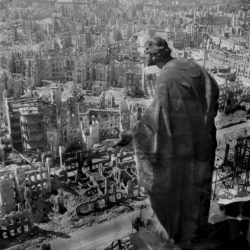
August T. M. Schreitmüller’s Die Gute (The Goodness) (1907) looks over the ruins of Dresden. This photograph, taken by German communist Richard Peters, becomes one of the most famous images of the war due to the controversy over the city’s bombardment.
| Aircraft Type | Serial No. | Code | Unit | ||
| Avro Lancaster Mk. III | LM682 | O | 103 Squadron | ||
| Avro Lancaster Mk. I | NG353 | X | 186 Squadron | ||
| Avro Lancaster Mk. III | PB183 | C | 405 Squadron | ||
| Avro Lancaster Mk. III | NG234 | E | 463 Squadron | ||
| Avro Lancaster Mk. I | PD232 | O2 | 576 Squadron |
| Aircraft Type | Serial No. | Name | Code | Unit | MACR |
| Boeing B-17G-95-BO | 43-38735 | Flat Top | PY-C | 407BS/92BG | 12354 |
| Boeing B-17G-60-BO | 42-102975 | Verna E | WW-F | 369BS/306BG | 12325 |
| Boeing B-17G-45-BO | 42-97185 | WW-J | 369BS/306BG | 12333 | |
| Boeing B-17G-85-BO | 43-38405 | YB-D | 508BS/351BG | 12334 | |
| Boeing B-17G-105-BO | 43-39147 | FO-O | 527BS/379BG | 12338 |
| Aircraft Type | Serial No. | Pilot | Code | Unit | MACR |
| North American P-51D-10-NA | 44-14319 | 1LT Jack D. Leon | KI-M | 55FS/20FG | 12326 |
| North American P-51D-10-NA | 44-14650 | 2LT Roy C. Garrett | CV-X | 368FS/359FG | 12329 |
| North American P-51D-15-NA | 44-14894 | LTC Roy W. Evans | IV-D | 369FS/359FG | 12330 |
19 February 1945
The US V Amphibious Corps (MajGen Harry Schmidt) initiates Operation DETACHMENT and begins the invasion of Iwo Jima. The island is slated to be used as a staging area for further operations against Japan and the 20AF is keen to use the island for bombers unable to return to the Marianas. More importantly, Iwo Jima is destined to serve as a home for long-range fighters of the 7AF (MG Robert W. Douglass, Jr.) assigned to provide escort to 20AF Boeing B-29s. The island’s location and volcanic topography ultimately make the island useless to naval and land forces, though its three airfields are refurbished to make way for the 7AF. Similar to their strategy in the Marianas but on a far larger scale, the Japanese use a complex tunnel system to slowly bleed the invading forces. The fanaticism of the Japanese defenders takes a heavy toll and the island is not deemed secure until 16 March 1945.
Chichi Jima, an island nearby, is bypassed, instead being bombed into submission. Ten US airmen are shot down over the island, with nine of them ultimately being murdered and eaten by their Japanese captors. Thirty of the Japanese servicemen stationed on Chichi Jima are tried for war crimes after the war, with four being hanged and the others serving a short prison sentence. The horrific fate of the POWs on Chichi Jima are indicative of Japanese hostility toward American bomber crews and many similar incidents follow in the coming months over mainland Japan.
| Allied Casualties: | approx. 6,821 out of 110,000 |
| Axis Casualties: | approx. 18,375 out of 21,060 |
| Axis POWs: | appox. 216 |
22 February 1945
The Western Allied powers initiate Operation CLARION. CLARION originated the previous year with a call from CG USAAF GA Henry H. Arnold for a maximum effort against 'virgin' targets in Germany - an airpower show-of-force. This however required not only clear weather but legitimate military objectives. This requirement eventually came with Operation GRENADE. An attempt by the US Ninth Army (LTG William H. Simpson) failed to link with the Canadian First Army (Lt Gen Harry D. G. Crerar) when German forces destroyed the dams on the Rur River (Operation VERITABLE) on 9 February 1945. GRENADE was to be the Ninth Army’s second attempt to cross the Rur, and Arnold’s maximum effort concept was revived as GRENADE's air component. In theory a strike against German rail hubs, CLARION ostensibly targets German towns that thus far avoided the ravages of war. The population of the towns targeted average 50,000 people.
For the bombers of USSTAF and RAF BC, the strike is made by individual units flying at altitudes averaging 10,000 ft; this not only allows for the comfort of flying without oxygen equipment, but greater visual accuracy. CLARION heavily disrupts Germany's transportation system and the German army's sluggishness in responding to the renewed drive east is widely noted in its aftermath.
It is striking to note that three of the four largest air efforts against civilians in the Second World War all occur in late-February/early-March 1945. It would seem that a new consciousness was reached throughout the Allied forces on the role of strategic air power. For the US, this may be the result of Arnold's impatience regarding decisive results. The braggadocio of American airmen had not paid off in the campaigns against Germany, at least, not to an extent satisfactory to airpower critics. The fact that CLARION was launched at the same time the US Army was preparing to enter Germany, and at the same time that the 20AF in the Pacific was beginning incendiary strikes, bears consideration. XO USSTAF MG Frederick L. Anderson, Jr. justified CLARION on the following basis:
...such an operation was not expected in itself to shorten the war – no such optimistic attitude existed here. However, it is expected that the fact that Germany was struck all over will be passed on, from father to son, thence to grandson; that a deterrent for the initiation of future wars will definitely result – a reluctance to participate in any organization that has war as its primary aim...
Just the same, CLARION is dutifully resisted by many air commanders, the most notable being CG MAAF LTG Ira C. Eaker and his G-3, BG Charles P. Cabbell. Eaker wrote a long critique of CLARION and Cabbell scribbled on the plans themselves that he viewed CLARION as a thinly-veiled attempt at morale bombing. After all, the deliberate targeting of civilians was an anathema to US air theory, and most had long abandoned any hope that Germany's willpower could be broken through bombardment. By contrast, CLARION is welcomed by Allied ground commanders, who seriously discuss the possibility of using airpower to blast pathways into Germany; CG US Third Army LTG George S. Patton, Jr., for example, suggests that if military objectives be necessary, labelling telephone switchboards as legitimate targets. Despite popular dismissal of CLARION's 'military objectives,' it is worth noting that just .02% of US bombs are composed of incendiaries and residential areas suffer surprisingly little damage this day. Allied forces finally crosses the Rhine River en masse on 22 March, beginning the formal invasion of Germany.
All nine Luftwaffe interceptors lost this day are Me-262 Schwalbe jet fighters.
| US 8AF Bombers Launched: | 1,428 |
| US 8AF Bombers Effective: | 1,372 |
| US 8AF Fighters Launched: | 862 |
| US 8AF Fighters Effective: | 817 |
| US 8AF Bombers MIA: | 7 |
| US 8AF Bombers Abort: | 56 |
| US 8AF Fighters MIA: | 13 |
| US 8AF Fighters DBR: | 1 |
| US 8AF Fighters Abort: | 45 |
| US 8AF Abort Rate: | 4% |
| US 8AF Loss Rate: | <1% |
| E/A Destroyed | 9 |
| RAF Bombers Launched: | 167 |
| RAF Bombers MIA: | 1 |
| RAF Bombers DBR: | 1 |
| RAF Loss Rate: | 1% |
| Aircraft Type | Serial No. | Name | Code | Unit | MACR |
| Boeing B-17G-105-BO | 43-39128 | Beatty's 8-Balls | N8-M | 600BS/398BG | 12650 |
| Boeing B-17G-45-VE | 44-8015 | Johnny Reb | 7D-U | 731BS/452BG | 12657 |
| Boeing B-17G-55-DL | 44-6599 | 4N-R | 833BS/486BG | 12661 | |
| Consolidated B-24H-25-FO | 42-95241 | Jolly Duck | EC-G | 578BS/392BG | 12658 |
| Consolidated B-24H-30-DT | 42-51215 | 7V-B | 752BS/458BG | 12659 | |
| Consolidated B-24J-55-CF | 44-10491 | Iron Duke | Z5-I | 754BS/458BG | 12675 |
| Consolidated B-24J-401-CF | 42-50462 | 3Q-unk | 852BS/491BG | 12653 |
| Aircraft Type | Serial No. | Pilot | Code | Unit | MACR |
| North American P-51D-15-NA | 44-15650 | FO Ralph E. Hamilton | HL-J | 83FS/78FG | 12681 |
| North American P-51K-5-NT | 44-11745 | CPT Ray F. Hermann | 5Q-C | 504FS/339FG | 12682 |
| North American P-51D-10-NA | 44-14153 | 2LT Robert T. Wood | 5Q-J | 504FS/339FG | 12687 |
| North American P-51D-10-NA | 44-14793 | 1LT John M. Balason | LH-J | 350FS/353FG | 12683 |
| North American P-51D-10-NA | 44-14275 | 1LT George A. Kemper, Jr. | WR-F | 354FS/355FG | 12671 |
| North American P-51D-15-NA | 44-15149 | 2LT Alden S. Thomas | PI-Y | 360FS/356FG | 12690 |
| North American P-51K-5-NT | 44-11647 | 2LT David P. Dumire | CV-F | 368FS/359FG | 12686 |
| North American P-51D-5-NA | 44-13610 | 2LT Russell E. Masters | IV-V | 369FS/359FG | 12652 |
| North American P-51D-5-NA | 44-13340 | 2LT Richard E. Chandler | B7-unk | 374FS/361FG | 12674 |
| North American P-51D-10-NA | 44-14747 | 1LT Frederick A. Ross | N2-Y | 383FS/364FG | 12673 |
| North American P-51D-NA | 44-13994 | 2LT Francis X. Radley | 5E-N | 385FS/364FG | 12685 |
| North American P-51D-15-NA | 44-15412 | 2LT Albert R. Di Paola | 9B-D | 436FS/479FG | 12692 |
| North American P-51K-5-NT | 44-11739 | 1LT Peter C. Vassuer | 9B-P | 436FS/479FG | 12672 |
| Aircraft Type | Serial No. | Code | Unit |
| Avro Lancaster Mk. I | NG450 | B | 218 Squadron |
4 March 1945
US XXI BC (20AF) launches 194 Boeing B-29s against the Nakajima Hikōki Kabushiki Kaisha (Nakajima Aircraft Co., Ltd.) in Tokyo, Japan. Due to bad weather the bombers go on to strike targets-of-opportunity. This is the last of twenty attempts toward a sustained precision bombing campaign against Japan, eight of which were launched under CG XXI BC MG Curtis E. LeMay.
During the operation, Dinah Might (42-65286, 9BG) is forced to make an emergency landing at South Field on Iwo Jima. While the Battle for Iwo Jima is still raging at this time, the bomber is able to be serviced and refueled before departing. The presence of Dinah Might antagonizes the Japanese defenders, who rashly abandon their tunnels to get to the bomber the night before her departure. The island is deemed secure just over a week later. Dinah Might is the first of 2,251 B-29 landings on Iwo Jima – a fact often brought up in justifying the taking of Iwo Jima as, in the end, approximately three airmen are saved for every Marine killed taking the island.
Despite said declaration, Iwo Jima suffers from the same issue as the occupied Marianas - intermittent surprise attacks by hidden Japanese. On 26 March, for example, the newly arrived 318FG earns the distinction of supposedly being the only USAAF unit to engage in ground combat. 15 AAF servicemen are killed quelling a Japanese attack on the unit's tent sleeping area.
| Bombers Launched: | 194 |
| Bombers Effective: | 179 |
| Bombers MIA: | 1 |
| Bombers Abort: | 15 |
| Abort Rate: | 8% |
| Loss Rate: | 1% |
| Aircraft Type | Serial No. | Name | Code | Unit | MACR |
| Boeing B-29-15-BA | 42-63412 | Peace On Earth | A-Square-25 | 870BS/497BG | 12912 |
Peace On Earth (42-63412, 497BG) ditches on the flight home.
9 March 1945
As per Operation MEETINGHOUSE, US XXI BC (20AF) launches this night 334 Boeing B-29s against Tokyo, Japan. Having proven the effectiveness of incendiary strikes with the 4 February attack on Kōbe, CG XXI BC MG Curtis E. LeMay now orders his bombers stripped of armament (save tail guns) and that operations be flown at lower altitudes to increase payload and decrease engine strain - this night, for example, sees the altitude drop from 27,000 ft to 7,050 ft. As a safety precaution, this strike (and future ones like it) is flown at night, taking into account the virtual nonexistence of Japan’s night-fighter force. These changes prove ruthlessly effective, with abort and loss rates dropping so much that LeMay's B-29s eventually have lower loss rate than the B-29's stateside training program. The strike is led by CG 314BW BG Tommy S. Power aboard Snatch Batch (42-65302, 29BG), listening with ironic morbidity to the Ink Spots' "I Don't Want To Set The World On Fire" on the flight in. This is the deadliest conventional bombing raid in human history. (83,793 killed)
Due to the inarguable success of MEETINGHOUSE, incendiary strikes against Japanese cities continue until the end of the war. LeMay launched the Tokyo strike without authorization from CG 20AF GA Henry H. Arnold, recognizing that, should it fail, the blame would have fallen entirely upon himself. The gamble paid off handsomely. MEETINGHOUSE is followed immediately by a series of similar operations, bombing Nagoya on 11 March, Ōsaka on 13 March, Kōbe on 16 March, and Nagoya again on 18 March. The frantic pace of these attacks give rise to the nickname "Blitz Week." LeMay justifies this dramatic shift in USAAF strategy by noting that Japanese cities fail to separate industrial districts from residential ones, with many plants subletting assemblies into employee’s homes. More importantly, with Japanese civilians having already proven a readiness to die in combat, such wanton destruction guarantees some alleviation for the invasion, now scheduled to begin in that autumn. CG USAAF GA Henry H. Arnold commends the 20AF on 18 March, stating:
The series of five major strikes you have performed in less than ten days constitutes an impressive achievement reflecting the greatest credit not only on the morale and fighting spirit of your crews, but equally on the determination and devotion of your ground personnel. Every member of your command is to be commended for his vital share in this accomplishment. This is a significant example of what the Jap can expect in the future. Good luck and good bombing.
Blitz Week comes to an end only because the 20AF runs out of incendiary bombs. Assuming the B-29 was to be used in the high-altitude, precision bombardment role, Army suppliers originally averaged the B-29's payload to 8,000 lbs per sortie - stripped of its armament and flying at low altitude, 20AF bombers are now averaging 14,000 lbs per sortie. This is why, for example, March's allotment of incendiaries, 9 million lbs, is insufficient to cover the 21.5 million lbs dropped this month. For a period after Blitz Week, 20AF operations are diverted to support the upcoming invasion of Okinawa (Operation ICEBERG), with precision strikes against aircraft factories, "potholing" raids against Japanese airfields, and mining operations off the Japanese coast. The 20AF resumes firebombing raids en masse on 14 May 1945 with a third strike against Nagoya.
| 9-Mar-45 | |
| Target: | Tokyo |
| Bombers Launched: | 334 |
| Bombers Effective: | 305 |
| Bombers MIA: | 14 |
| Bombers Abort: | 29 |
| Abort Rate: | 9% |
| Loss Rate: | 4% |
| 11-Mar-45 | |
| Target: | Nagoya |
| Bombers Launched: | 313 |
| Bombers Effective: | 294 |
| Bombers MIA: | 1 |
| Bombers Abort: | 19 |
| Abort Rate: | 6% |
| Loss Rate: | <1% |
| 13-Mar-45 | |
| Target: | Ōsaka |
| Bombers Launched: | 301 |
| Bombers Effective: | 285 |
| Bombers MIA: | 2 |
| Bombers DBR: | 1 |
| Bombers Abort: | 16 |
| Abort Rate: | 5% |
| Loss Rate: | 1% |
| 16-Mar-45 | Kōbe |
| Target: | |
| Bombers Launched: | 334 |
| Bombers Effective: | 313 |
| Bombers MIA: | 3 |
| Bombers Abort: | 21 |
| Abort Rate: | 6% |
| Loss Rate: | 1% |
| 18-Mar-45 | |
| Target: | Nagoya |
| Bombers Launched: | 313 |
| Bombers Effective: | 293 |
| Bombers MIA: | 1 |
| Bombers DBR: | 1 |
| Bombers Abort: | 20 |
| Abort Rate: | 6% |
| Loss Rate: | 1% |
| Aircraft Type | Serial No. | Name | Code | Unit | MACR |
| Boeing B-29A-10-BN | 42-93902 | Grand Slam | L-32 | 39BS/6BG |
| Boeing B-29-25-MO | 42-65298 | X-44 | 1BS/9BG | 16145 |
| Boeing B-29-50-BW | 42-24875 | Li'l Iodine | X-7 | 99BS/9BG |
| Boeing B-29-30-BA | 42-63569 | Zero Avenger | M-11 | 28BS/19BG | 13822 |
| Boeing B-29-25-MO | 42-65310 | M-unk | 93BS/19BG | 13825 |
| Boeing B-29-55-BW | 44-69686 | Tall In The Saddle | M-unk | 93BS/19BG | 13857 |
| Boeing B-29-25-MO | 42-65311 | O-14 | 6BS/29BG |
| Boeing B-29-55-BW | 44-69691 | Tiny Tim | O-28 | 42BS/29BG | 12967 |
| Boeing B-29A-10-BN | 42-93905 | O-26 | 52BS/29BG | 12972 |
| Boeing B-29-30-BA | 42-63564 | Cherry-Horizontal Cat | O-41 | 52BS/29BG | 12968 |
| Boeing B-29-25-MO | 42-65301 | O-47 | 52BS/29BG | 12975 |
| Boeing B-29-55-BW | 44-69703 | A-unk | 869BS/497BG |
| Boeing B-29-60-BW | 44-69747 | T-15 | 873BS/498BG | 12949 |
| Boeing B-29-20-BA | 42-63482 | Hope-Full Devil | K-unk | 484BS/505BG |
11-Mar-45
| Boeing B-29-45-BW | 42-24753 | V-45 | 879BS/499BG | 12989 |
13-Mar-45
| Boeing B-29-40-BW | 42-24610 | Bedroom Eyes | T-22 | 874BS/498BG | 13018 |
| Boeing B-29-45-BW | 42-24754 | V-30 | 879BS/499BG | 13017 |
16-Mar-45
| Boeing B-29-25-BA | 42-63546 | Indiana | X-44 | 99BS/9BG | 14272 |
| Boeing B-29-45-BW | 42-24849 | Mission To Albuquerque | Z-8 | 881BS/500BG | 13079 |
| Boeing B-29-20-MO | 42-65242 | E-unk | 398BS/504BG | 14246 |
18-Mar-45
| Boeing B-29-45-BW | 42-24797 | Jackpot | K-unk | 484BG/505BG | 13694 |
Mission To Albuquerque (42-24849, 500BG) is rammed by a Ki-61 Tony piloted by Taii Junichi Ogata (56 Sentai). The two surviving crewmen are executed by their captors on 18 July 1945. Mission To Albuquerque is the only B-29 lost to air interception during Blitz Week.
12 March 1945
The US 8AF launches 457 Boeing B-17s and 227 Consolidated B-24s, escorted by 452 North American P-51s, against the port of Świnoujście, Poland. The strike was requested by Soviet Premier Joseph V. J. Stalin three days prior to aid in slowing Operation HANNIBAL - the German evacuation of East Prussia, by now almost surrounded. With the city choked with refugees, civilian casualties are unusually high, leading to the strike becoming historiographically controversial with claims that the bombers purposely dropped fragmentation bombs and strafed civilians. While it is true that the bombers dropped via radar (typical in overcast operations), primary sources show the bombers did not carry fragmentation bombs. Likewise, it is unlikely that US fighters strafed the city's civilians. Records show that fighter pilots were strictly instructed to avoid strafing so close to Soviet lines, and it is worth noting that doing so would have been impossible during the bombardment and unlikely afterward due to the smoke. It is more likely that the reports of strafing refer to Soviet tactical aircraft also in the vicinity. (Approx. 4,500 killed)
Despite being targeted via radar, accuracy over the target is good and the 2AD (which leads the strike) is officially commended for not accidentally hitting Soviet lines, just miles away.
| Bombers Launched: | 677 |
| Bombers Effective: | 662 |
| Fighters Launched: | 452 |
| Fighters Effective: | 412 |
| Bombers MIA: | 1 |
| Bombers Abort: | 15 |
| Fighters MIA: | 4 |
| Fighters DBR: | 1 |
| Fighters Abort: | 40 |
| Abort Rate: | 2% |
| Loss Rate: | <1% |
| Aircraft Type | Serial No. | Name | Code | Unit | MACR |
| Boeing B-17G-70-VE | 44-8577 | PY-M | 407BS/92BG | 13093 |
"M-Mike" (44-8577, 92BG) lands in neutral Sweden and is interned.
| Aircraft Type | Serial No. | Pilot | Code | Unit | MACR |
| North American P-51D-10-NA | 44-14350 | MAJ John D. McFarlane | VF-L | 336FS/4FG | 13394 |
| North American P-51D-20-NA | 44-72214 | 1LT Dean C. Johnson | HL-A | 83FS/78FG | 13416 |
| North American P-51D-20-NA | 44-72200 | 1LT Anton A. Rosengreen | WZ-N | 84FS/78FG |
| North American P-51D-10-NA | 44-14086 | 1LT Richard C. O'Brien | 6N-D | 505FS/339FG | 13417 |
"N-Nancy" (44-72200, 78FG) ditches in the North Sea.
14 March 1945
RAF BC launches four de Havilland Mosquitoes and 32 Avro Lancasters against the giant railway viaducts of Bielefeld and Arnsberg, Germany. This day sees the first use of the 22,000 lb “Grand Slam” developed by Barnes N. Wallis. While the 12,000 lb Tallboy proved successful since its introduction on 8 June 1944, the bomb was still half the size which Wallis first proposed to the Air Ministry in his 1941 report A Note on a Method of Attacking the Axis Powers. While Wallis anticipated needing a new aircraft design to carry such a bomb, the realization that the Lancaster could, with minor alterations, actually carry the weight allowed for larger bomb development. The Grand Slam was incredibly heavy – 8,000 lbs heavier than the Lancaster’s maximum bombload – and 32 Lancasters were altered by adding new Rolls Royce Merlin 24 engines and removing the bombbay doors, radar, armor, and top and nose turrets. There was certainly some compromise involved, as Wallis designed the Tallboy and Grand Slam with the intention of dropping them at altitudes above 40,000 ft, - an altitude no RAF bomber could reach. Whereas the Tallboy was usually dropped at around 18,000 ft, the weight of the Grand Slam is such that its carriers struggle to reach 12,000 ft. Regardless, the Grand Slam proves ruthlessly effective, and is the only bomb developed during the war found truly efficient at destroying hardened targets like submarine pens. Some 41 Grand Slams are dropped by war’s end, sparing a planned campaign against Germany’s subterranean production facilities.
The Grand Slam is the largest conventional bomb ever used in combat. There is a caveat here: the US GBU-43 MOAB (Massive Ordnance Air Blast), dropped on 13 April 2017 against Islamic terrorists on the Afghan-Pakistan border, is larger on the basis of technicality. While the MOAB, pushed out the back of a Lockheed C-130, weighs 21,600 lbs, its filling weight is substantially larger than the Grand Slam, being filled with 18,700 lbs of explosive rather than 9,500 lbs. Interestingly, the modern H-6 filling of the MOAB is not at all dissimilar to the torpex used on the Grand Slam.
24 March 1945
The US 15AF launches 170 Boeing B-17s and 527 Consolidated B-24s, escorted by 105 Lockheed P-38s and 289 North American P-51s, against the Daimler-Benz plant of Berlin, the railyards of Budweis (České Budějovice, Czechoslovakia), and the airfields of Neuburg an der Donau and Munich, Germany. This 1,600 mi operation earns the distinction of being the longest bomber strike launched in the ETO.
This operation is often prominently featured in histories of the 332FG - the so-called "Tuskegee Airmen." An all-black unit trained at Tuskegee University, a series of myths have arisen regarding their combat record, particularly in regard to this operation. First, the idea that they were somehow requested for escort-duty makes no sense. As is typical, the 332FG is one of a host of fighter units flying escort duty this day. The myth seems to stem from two origins: a poor-weather grounding of a few B-24s at Ramitelli Field (the 332FG's base) and COL Benjamin O. Davis, Jr. having named his P-51 By Request (a reference to civil rights efforts to form the unit). Second, the claim that the 332FG never lost a bomber to enemy action is patently false as, for example, this day's strike sees the 332FG lose three of their wards to fighter interception. Lastly, the argument that the Tuskegee Airmen are one the first units to engage German jet fighters is misleading. US 8AF units were engaged with jet fighters for nearly a year by this point, and while three 332FG pilots claim jet victories this day, it should be noted that this is the third time 15AF airmen had done so.
It is also prudent to note that these myths largely originate not from the airmen themselves, but from the American press. Before the war even ended, articles by black-activist writers like V. L. "Roi" Ottley and publications like the Chicago Defender exaggerated the 332FG's accomplishments, tainting an honorable combat record for political gain. In fact, this very day sees the Chicago Defender repeat the 'never lost a bomber' claim in one of its articles. An attempt to form a Tuskegee bomber unit, the 477BG, fails when its officers stage a mutiny at Freeman Field near Seymour, IN over racially segregated officers clubs.
While the Luftwaffe jet inceptor unit this day - JG7 - only records four operational losses, US victory claims against the Me-262 Schwalbe jet fighter total 11. Of these 11, six are made by aerial gunners of the 483BG, whose Big Yank (44-6405, 483BG) becomes a minor celebrity. Big Yank's gunners claim a whopping three jets kills - two via tail gunner SSGT Lincoln F. Broyhill and one via ball turret gunner SSGT Cecil E. Shellabarger. If this is true, Big Yank has the highest number of jet kills of any bomber until the Boeing B-29 Command Decision (44-87657, 19BG) claims of five MiG-15 Fagots on 27 October 1951.
| Bombers Launched: | 697 |
| Bombers Effective: | 658 |
| Fighters Launched: | 397 |
| Fighters Effective: | 367 |
| Bombers MIA: | 10 |
| Bombers Abort: | 39 |
| Fighters MIA: | 5 |
| Fighters Abort: | 30 |
| Abort Rate: | 6% |
| Loss Rate: | 2% |
| E/A Destroyed: | 4 |
| Aircraft Type | Serial No. | Name | Code | Unit | MACR |
| Boeing B-17G-60-DL | 44-6718 | 20BG/2BG | 13374 | ||
| Boeing B-17G-50-VE | 44-8162 | 429BS/2BG | 13372 | ||
| Boeing B-17G-65-VE | 44-8498 | Wheel Wagon | 772BS/463BG | 13258 | |
| Boeing B-17G-60-DL | 44-6702 | Umbriago | 772BS/463BG | 13271 | |
| Boeing B-17G-65-DL | 44-6761 | 773BS/463BG | 13274 | ||
| Boeing B-17G-50-DL | 44-6283 | Betty Lou | 773BS/463BG | 13278 | |
| Boeing B-17G-60-DL | 44-6686 | 774BS/463BG | 13208 | ||
| Boeing B-17G-60-DL | 44-6640 | Laetitia | 775BS/463BG | 13371 | |
| Boeing B-17G-50-VE | 44-8159 | 817BS/483BG | 13375 | ||
| Consolidated B-24J-195-CO | 44-41075 | Ole 075 | 756BS/459BG | 13264 |
Ole 075 (44-41075, 459BG) lands in neutral Switzerland and is interned.
| Aircraft Type | Serial No. | Pilot | Code | Unit | MACR |
| North American P-51B-10-NA | 42-106622 | 2LT Ronald W. Reeves | 100FS/332FG | 13269 |
| North American P-51C-10-NA | 44-10955 | 2LT Robert C. Robinson, Jr. | 100FS/332FG | 13270 |
| North American P-51C-10-NA | 42-103905 | FO Leon W. Spears | 301FS/332FG | 13266 |
| North American P-51B-15-NA | 43-24864 | CPT Armour G. McDaniel | 301FS/332FG | 13267 |
| North American P-51C-7-NA | 42-103611 | FO James T. Mitchell, Jr. | 301FS/332FG | 13268 |
27 March 1945
As per Operation STARVATION, US XXI BC (20AF) has 104 of its Boeing B-29s mine the Shimonoseki Strait (Kanmon Straits) between Honshū and Kyūshū this night. These are the first of a series of minelaying sorties, long advocated by POA CINC FADM Chester W. Nimitz and finally approved by CG USAAF GA Henry H. Arnold. The B-29s parachute-drop Mk 25 2,000 lb magnetic anti-shipping mines (acoustically triggered), deploying a total of 12,135 mines in 46 missions by war’s end. Shockingly, STARVATION sinks more shipping in six months than any of the other Allied services, sinking or damaging 670 ships at the loss of 15 B-29s. Lacking sufficient imports, the Japanese economy crumbles and government publications begin to encourage its people to eat grasshoppers.
| Bombers Launched: | 107 |
| Bombers Effective: | 96 |
| Bombers Abort: | 11 |
| Abort Rate: | 6% |
29 March 1945
With the last remaining bomb wing (the 58BW) having already moved its HQ, US XX BC (20AF) launches its 49th and final combat operation out of East Asia before being absorbed into the XX BC (20AF) in the Marianas. This night sees 29 Boeing B-29s strike the oil storage facilities of Pulau Bukom, off the coast of Singapore.
| Bombers Launched: | 29 |
| Bombers Effective: | 26 |
| Bombers Abort: | 3 |
| Abort Rate: | 10% |
Four days later, CO 505BG COL Robert A. Ping issues a directive on the subject of nose-art. It reads:
Group commanders will see that all pictures of women are removed from aircraft in their group. . . .
2. It is with deep regret that I receive and must of course, carry out the above order. I realize what it means to those concerned to remove the ‘women’ from their airplanes; they have somehow become part of the missions that have been flown. Some of you have spent hard-earned ‘cash’ for these ‘women.’ All this I realize, but they must go.
3. General Arnold and commanders on down the chain of command somehow feel that the B-29 is a cut above the ordinary airplane, and being so, is not to be placed in the common class by pictures of nude women.
4. Insignia of sponsors . . . may be retained, however, they are to go only on the right side of the nose section…
Despite coming directly from CG USAAF GA Henry H. Arnold, the attempt to censor B-29 nose-art is barely followed. The 73BW and 313BW both adopt nose-art templates which crews can use, following the directive mentioned above, while the 314BW goes a step further, requiring all custom names come from US cities. The remaining bomb wings - the 58BW and 315BW - simply ignore the order. 73BW veterans blame the directive on First Lady A. Eleanor Roosevelt (D-NY), who was apparently disgusted while on an inspection tour of US airbases. In the end, most bombardment groups skirt the issue by ensuring their aircraft are given artwork on both sides of the nose: a normal side for aircrews and a clean side for photographers.
31 March 1945
US XXI BC (20AF) launches 152 Boeing B-29s against the Kyushu Hikōki (Aircraft) works of Tachiarai and the airfields of Oita and Omura, Japan. Due to unusually good weather, the bombing results this day are superb. A portion of this day's strike is broadcast over the radio on 7 April in the United States. An attempt at real-time combat reporting, sound engineers from various combat theaters submit segments to ABC's Blue Network, which are then punctuated with relevant interviews. The recording from this day's strike is a ten minute segment recorded by SSGT Hal Brown aboard City of Muncie (42-65350, 29BG). The segment, recorded during the bomb run with Brown quietly recounting what he sees, is followed by live interviews with families of the crew. Unknown to the families, the City of Muncie is rammed by a Japanese interceptor, killing all but three, on the day of said interview.
Click hear to listen to the Fighting AAF Broadcast of 7 April 19
| Bombers Launched: | 152 |
| Bombers Effective: | 137 |
| Bombers MIA: | 1 |
| Bombers Abort: | 15 |
| Abort Rate: | 10% |
| Loss Rate: | 1% |
| Aircraft Type | Serial No. | Name | Code | Unit | MACR |
| Boeing B-29-45-BW | 42-24727 | T-1 | 873BS/498BG | 14233 |
"Tare-Square-1" ditches en route to the target when her no. 3 engine overheats and catches fire.
6 April 1945
The US 8AF launches 452 Boeing B-17s and 207 Consolidated B-24s, escorted by 39 Republic P-47s and 627 North American P-51s, against the railyards of Leipzig and Halle, Germany. Due to poor weather all targets are attacked via radar. This strike sees MSGT Hewitt T. Dunn complete his 100th combat mission, flying as togglier aboard The Great McGinty (43-38663, 390BG). An aerial gunner who flew his first mission on 29 January 1944, Dunn was the most decorated airman of the 8AF and is believed to have flown more heavy bomber operations than any American airman in the Second World War. Staying despite having completed three tours-of-duty, Dunn flies four more missions before the war’s end.
Despite these accolades, Dunn’s achievements are quickly forgotten due to the circumstances of his postwar death at age 41. On 15 June 1961, Dunn and his wife got into a drunken argument at their Castle AFB home near Atwater CA. Beating his wife Peggy and throwing her in the yard, Dunn’s son Craig, age 13, came to the defense of his mother with a .22 rifle and killed Dunn with five shots to the torso.
| Bombers Launched: | 659 |
| Bombers Effective: | 646 |
| Fighters Launched: | 666 |
| Fighters Effective: | 630 |
| Bombers MIA: | 6 |
| Bombers DBR: | 2 |
| Bombers Abort: | 13 |
| Fighters MIA: | 1 |
| Fighters Abort: | 36 |
| Abort Rate: | 2% |
| Loss Rate: | 1% |
| Aircraft Type | Serial No. | Name | Code | Unit | MACR |
| Boeing B-17G-35-DL | 42-107204 | Goin' My Way | OE-B | 335BS/95BG | 15598 |
| Boeing B-17G-75-VE | 44-8647 | PU-M | 360BS/303BG | 13596 | |
| Boeing B-17G-100-BO | 43-38958 | Green Hill Belle | GN-H | 427BS/303BG | 13719 |
| Boeing B-17G-105-BO | 43-39164 | SU-F | 544BS/384BG | 13850 | |
| Boeing B-17G-95-BO | 43-38801 | Ruth | SU-M | 544BS/384BG | 13851 |
| Boeing B-17G-70-DL | 44-6923 | JD-J | 545BS/384BG | 15356 |
"J-Jig" (44-6923, 384BG) crashes on takeoff.
Green Hill Belle (43-38958) and "M-Mike" (44-8647) of the 303BG suffer a mid-air collision. Likewise, Ruth (43-38801) and "F-Fox" (43-39164) of the 384BG also suffer a mid-air collision.
| Aircraft Type | Serial No. | Pilot | Code | Unit | MACR |
| North American P-51D-15-NA | 44-15552 | 1LT Raleigh S. Ragsdale, Jr. | PI-Q | 360FS/356FG | 13961 |
7 April 1945
US XXI BC (20AF) launches 306 Boeing B-29s against the Nakajima Hikōki (Nakajima Aircraft) plant of Tokyo and the Mitsubishi Jukogyo (Mitsubishi Heavy Industries) plant of Nagoya, Japan. This day sees the first use of fighter escorts for the B-29s, with 108 North American P-51s being launched from their newly-settled bases on Iwo Jima. The P-51s are part of the 7AF and are equipped with 165 gallon droptanks rather than the standard 108 gallon tanks previously in use.
Unfortunately, the deployment of fighter escorts for the 20AF proves to be a mistake. The long-distances involved are taxing on fighter pilots and makeshift hot springs are set up for airmen so stiff that they have to be physically removed from their aircraft; due to these conditions, fighter pilots begin to rotate out after a mere 15 combat missions. Japanese resistance is pitifully weak and most fighter sorties resort to strafing of targets-of-opportunity.
| North American P-51D | ||||||
| Fuel Capacity: | 269 gal | |||||
| Combat Radius - Standard: | 475 mi | |||||
| Combat Radius - x2 75 gal droptanks: | 650 mi | |||||
| Combat Radius - x2 108 gal droptanks: | 850 mi | |||||
| Combat Radius - x2 165 gal droptanks: | 975 mi | |||||
This day also sees the one and only use of Ki-46 Dinahs in the interceptor role, being adopted for their high service ceiling. The Dinahs drop 110 lb cluster bombs over US formations, successfully downing B-29 "Victor-Square-25" (42-24674, 499BG). The converted reconnaissance-fighters prove easy prey to escorting P-51s, as five are shot down in quick succession, prompting their hasty retirement.
| Bombers Launched: | 306 |
| Bombers Effective: | 290 |
| Fighters Launched: | 108 |
| Fighters Effective: | 91 |
| Bombers MIA: | 5 |
| Bombers DBR: | 1 |
| Bombers Abort: | 16 |
| Fighters MIA: | 1 |
| Fighters DBR: | 1 |
| Fighters Abort: | 17 |
| Abort Rate: | 5% |
| Loss Rate: | 2% |
| Aircraft Type | Serial No. | Name | Code | Unit | MACR |
| Boeing B-29-30-MO | 42-65350 | City Of Muncie | O-6 | 6BS/29BG | 14232 |
| Boeing B-29-55-BW | 44-69669 | O-12 | 6BS/29BG | 14231 | |
| Boeing B-29-10-MO | 42-65212 | Mrs. Tittymouse | T-47 | 875BS/498BG | 13658 |
| Boeing B-29-45-BW | 42-24674 | V-25 | 879BS/499BG | 13625 | |
| Boeing B-29-40-BW | 42-24600 | Adam's Eve | Z-47 | 883BS/500BG | 13657 |
City of Muncie (42-65350, 29BG), Mrs. Tittymouse (42-65212, 499BG), and Adam's Eve (42-24600, 500BG) are rammed by Japanese interceptors.
| Aircraft Type | Serial No. | Pilot | Code | Unit | MACR |
| North American P-51D | unk | 1LT Frank K. Ayres | unk | 47FS/21FG |
1LT Frank K. Ayres ditches into the Pacific after running out of fuel and is picked up by the USS Cassin (DD-372).
Lastly, the US 8AF launches 974 Boeing B-17s and 340 Consolidated B-24s, escorted by 55 Republic P-47s and 843 North American P-51s, against the airfields of Kaltenkirchen, Parchim, Westendorf, and Amelinghausen, the oil depots of Buchen and Hitzacker, and the munitions depots of Güstrow, Haren, and Krümmel, Germany. This strike sees the one and only combat deployment of Luftwaffe Sonderkommando (Special Command) Elbe as per Operation WERWOLF (Werewolf). A last ditch effort to turn the tide of the Allied bombing campaign, the unit is specially trained to ram US bombers, bailing out just before impact. B-24L Palace of Dallas (44-49254, 389BG) is the first hit when a Bf-109 piloted by Uffz Heinrich Rosner careens threw the aircraft and into nearby "P-Peter" (44-49533, 389BG). While 15 bombers are rammed this day, only eight are destroyed and the program is brought to a halt mere days after.
| Bombers Launched: | 1,314 | |
| Bombers Effective: | 1,261 | |
| Fighters Launched: | 898 | |
| Fighters Effective: | 830 | |
| Bombers MIA: | 17 | |
| Bombers DBR: | 1 | |
| Bombers Abort: | 53 | |
| Fighters MIA: | 5 | |
| Fighters DBR: | 2 | |
| Fighters Abort: | 68 | |
| Abort Rate: | 4% | |
| Loss Rate: | 1% | |
| E/A Destroyed: | 49* | |
*45 of this days' 49 Luftwaffe losses are from Sonderkommando Elbe.
| Aircraft Type | Serial No. | Name | Code | Unit | MACR |
| Boeing B-17G-60-VE | 44-8334 | XR-M | 349BS/100BG | 13716 | |
| Boeing B-17G-40-BO | 42-97071 | Candy's Dandy | LD-P | 418BS/100BG | 13718 |
| Boeing B-17G-80-VE | 44-8744 | SG-L | 550BS/385BG | 13721 | |
| Boeing B-17G-40-BO | 42-97105 | G | 561BS/388BG | 13724 | |
| Boeing B-17G-95-BO | 43-38869 | Paula Sue | unk | 563BS/388BG | 13723 |
| Boeing B-17G-55-VE | 44-8225 | Hard To Get | DI-L | 570BS/390BG | 13891 |
| Boeing B-17G-75-VE | 44-8634 | Ida Wanna | 9Z-unk | 728BS/452BG | 14184 |
| Boeing B-17G-70-VE | 44-8531 | Miasis Dragon | 9Z-unk | 728BS/452BG | 13893 |
| Boeing B-17G-95-BO | 43-38868 | 9Z-unk | 728BS/452BG | 13888 | |
| Boeing B-17F-30-DL | 42-31366 | Old Outhouse | 7D-unk | 731BS/452BS | 13886 |
| Boeing B-17G-70-VE | 44-8528 | Flak Sack | 2S-L | 834BS/486BG | 14187 |
| Boeing B-17G-105-BO | 43-39163 | Happy Warrior | H8-S | 835BS/486BG | 13889 |
| Boeing B-17G-80-BO | 43-38082 | Lady Helene | 7Q-unk | 850BS/490BG | 14294 |
| Boeing B-17G-100-BO | 43-39070 | N6-unk | 860BS/493BG | 13890 | |
| Consolidated B-24L-10-FO | 44-49533 | RR-P | 566BS/389BG | 13892 | |
| Consolidated B-24L-5-FO | 44-49254 | Palace of Dallas | HP-K | 567BS/389BG | 14113 |
| Consolidated B-24H-20-FO | 42-94870 | Axis Ex-Lax | WV-E | 702BS/445BG | 13894 |
Aircraft highlighted are those rammed by fighters of Sonderkommando Elbe.
| Aircraft Type | Serial No. | Pilot | Code | Unit | MACR |
| North American P-51D-20-NA | 44-72296 | 2LT Harold J. Konantz | CL-P | 338FS/55FG | 13949 |
| North American P-51D-20-NA | 44-72217 | 2LT Robert H. Talbot | HL-H | 83FS/78FG | 13952 |
| North American P-51D-5-NA | 44-11325 | 1LT David A. MacKenzie | D7-K | 503FS/339FG | 13953 |
| North American P-51D-20-NA | 44-72306 | 2LT Newell F. Mills | WR-I | 354FS/355FG | 13960 |
| North American P-51D-15-NA | 44-15346 | 2LT Gilbert M. Plowman | WR-Z | 354FS/355FG | 13958 |
2LT Harold J. Konantz (44-72296, 55FG) is shot down by friendly-fire from his bomber wards.
25 April 1945
RAF BC launches 308 Handley Page Halifaxes, 16 de Havilland Mosquitoes, and 158 Avro Lancasters against the island of Wangerooge near Wilhelmshaven, while another force of 16 Mosquitoes and 359 Lancasters attack the “Eagle’s Nest” (German Führer Adolf Hitler’s private chateau) near Berchtesgaden, Germany. The attack against the Eagle’s Nest sees the last operational use of the 12,000 lb TALLBOY bomb. (306 killed)
Meanwhile, the US 8AF launches 307 Boeing B-17s and 282 Consolidated B-24s, escorted by 584 North American P-51s, against the Škoda Works of Plzeň, Czechoslovakia, the marshalling yards of Salzburg, Austria, and Bad Reichenhall, Germany, and the power plants of Traunstein, Germany. By this time, preparations are already underway to transfer the 8AF to Okinawa (still being taken) to begin operations against Japan. This process is complicated by the need to transition crews to the Boeing B-29 and rotate them through the United States.
For most Allied strategic air units in Northern Europe, this is the last strike of the war. The US 15AF flies its final mission - a 27-strong B-17 strike against the marshalling yards of Salzburg, Austria - on 1 May.
The record holders for the most sorties flown on the B-17, B-24, and Halifax all fly their last sorties this day: B-17G Ol' Gappy (42-0003, 379BG) flies her 157th mission, B-24H Witchcraft (42-52534, 467BG) flies her 130th mission, and Halifax Mk. III Friday the 13th (LV907, 158 Squadron) flies her 128th mission. Ol' Gappy and Witchcraft are scrapped shortly after the war, and while Friday the 13th is put on outdoor display in London for a brief period, she too is ultimately scrapped for her aluminum. Friday the 13th's noseart is preserved before this takes place and is ultimately placed on display at the Royal Air Force Museum just outside of London.
| RAF Bombers Launched: | 857 | |
| RAF Bombers MIA: | 10 | |
| RAF Loss Rate: | 1% | |
| US 8AF Bombers Launched: | 589 | |
| US 8AF Bombers Effective: | 554 | |
| US 8AF Fighters Launched: | 584 | |
| US 8AF Fighters Effective: | 539 | |
| US 8AF Bombers MIA: | 6 | |
| US 8AF Bombers DBR: | 4 | |
| US 8AF Bombers Abort: | 35 | |
| US 8AF Fighters MIA: | 1 | |
| US 8AF Fighters Abort: | 45 | |
| US 8AF Abort Rate: | 6% | |
| US 8AF Loss Rate: | 2% | |
| E/A Destroyed: | 2 | |
| Aircraft Type | Serial No. | Code | Unit | ||
| Handley Page Halifax Mk. VI | RG591 | A | 76 Squadron | ||
| Handley Page Halifax Mk. VI | RG553 | T | 76 Squadron | ||
| Handley Page Halifax Mk. VI | NP921 | E | 347 Squadron | ||
| Handley Page Halifax Mk. VII | NP796 | M | 408 Squadron | ||
| Handley Page Halifax Mk. VII | NP820 | W | 426 Squadron | ||
| Avro Lancaster Mk. X | KB831 | R | 431 Squadron | ||
| Avro Lancaster Mk. X | KB822 | W | 431 Squadron | ||
| Avro Lancaster Mk. I | NX585 | M | 460 Squadron | ||
| Avro Lancaster Mk. I | RA542 | Z | 463 Squadron | ||
| Avro Lancaster Mk. III | LM756 | F | 619 Squadron |
Halifaxes "A for Able," "T for Tommy," "M for Mike," "W for Willy," and Lancasters "R for Robert" and "W for Willy" suffer midair collisions, while Lancaster Mk. I "Z for Zebra" lands in neutral Sweden and is interned.
| Aircraft Type | Serial No. | Name | Code | Unit | MACR |
| Boeing B-17G-85-BO | 43-38369 | Checkerboard | NV-U | 325BS/92BG | 14222 |
| Boeing B-17G-80-DL | 44-83447 | GN-unk | 427BS/303BG | 14223 | |
| Boeing B-17G-80-BO | 43-38178 | Seattle Sue | FR-P | 525BS/379BG | 14319 |
| Boeing B-17G-90-BO | 43-38501 | Sweet Chariot | BK-C | 546BS/384BG | 14317 |
| Boeing B-17G-90-BO | 43-38652 | Stinker, Jr. | K8-V | 602BS/398BG | 14220 |
| Boeing B-17G-45-BO | 42-97266 | Godfather's Inc. | K8-G | 602BS/398BG | 14224 |
Suffering a mid-air collision with Thumper (43-38272, 379BG), Seattle Sue (43-38178, 379BG) is the last combat loss of a US 8AF bomber in the Second World War.
| Aircraft Type | Serial No. | Pilot | Code | Unit | MACR |
| North American P-51D-15-NA | 44-15347 | 1LT William B. Hoelscher | QP-J | 4FG | 14047 |
5 May 1945
The US 20AF launches 178 Boeing B-29s against the Kure Kaigun Kosho (Kure Naval Arsenal) while another 65 strike the airfields of Ōita, Tachiarai, Kanoya, and Chīrān, Japan. The bombers are escorted by North American P-51s of the 7AF. One of the bombers assigned to bomb Tachiarai, 42-65305 (29BG), is rammed by a N1K George flown by Suiheichō Kinzou Kasuya. While Japanese treatment of POWs - particularly airmen - was always shockingly cruel, the fate of this particular aircrew bears consideration as they are subjected to one of the most horrific massacres in military history.
All 12 airmen aboard 42-65305 successfully bail out, though one is killed when his parachute is entangled by a passing Japanese fighter. Upon landing, another is hacked to death by civilians, with one crewmen committing suicide rather than endure the same fate. The pilot is taken away for interrogation while the others, heavily wounded, are taken by local authorities to Kyūshū Daigaku (Kyushu University). These remaining eight airmen are placed on display in a lecture hall before students and special guests, where they are dissected fully-conscious and without painkillers. Some of the more printable experiments include injecting one airmen with seawater, and drilling a hole in the skull of another to watch his body respond to the twisting of the knife. Various portions of these airmen are afterward preserved and eaten - a surprisingly common fate of Allied POWs in Japanese custody.
After the war, some 30 people are arrested for the Kyushu vivisection, 23 of which are convicted of war crimes (though charges of cannibalism are dropped due to lack of physical evidence). Five are sentenced to death, including head surgeon Ishiyama Fukujirō, and another four are given life-in-prison. In a shameful attempt at mending national relations, GA Douglas MacArthur (commanding Japan's postwar occupation) commutes the sentences of all those convicted in 1950.
| Bombers Launched: | 243 |
| Bombers Effective: | 216 |
| Bombers MIA: | 5 |
| Bombers DBR: | 1 |
| Bombers Abort: | 27 |
| Abort Rate: | 11% |
| Loss Rate: | 2% |
| Aircraft Type | Serial No. | Name | Code | Unit | MACR |
| Boeing B-29A-15-BN | 42-93953 | O-unk | 6BS/29BG | 14364 | |
| Boeing B-29-25-MO | 42-65305 | O-unk | 6BS/29BG | 14363 | |
| Boeing B-29-30-BW | 42-24471 | Chattanooga Choo-Choo | I-14 | 792BS/468BG | |
| Boeing B-29-65-BW | 44-69899 | A-unk | 871BS/497BG | 14365 | |
| Boeing B-29-15-BA | 42-63416 | T-46 | 875BS/498BG | 14366 |
7 May 1945
The Second World War's European Theater of Operations comes to a close after five years, eight months, and five days. Following German Führer Adolf Hitler’s suicide on 30 April and multiple attempts to secure a peace with the Allied powers apart from the Soviet Union, Reichspräsident Karl Dönitz finally authorizes a formal unconditional surrender through GenObt Alfred J. F. Jodl in Reims, France. Not content with this arrangement, Soviet Premier Joseph V. J. Stalin demands a second surrender take place under Soviet supervision, with GenFM Wilhelm B. J. G. Keitel surrendering to Soviet forces in Berlin, Germany the following day.
Click here to read the German Acts of Surrender.
16 May 1945
The US 20AF launches 522 Boeing B-29s against Nagoya while another 31 mine the Shimonoseki straits. One of the bombers, Thumper (42-24623, 497BG), flies her 40th and final mission this night, returning to the US for a war bond tour days later. While Thumper was assigned two combat crews, her publicity tour is flown by an ad hoc collection of airmen who had completed their tours-of-duty, led by CO 870BS LTC Robert E. Haynes. Haynes piloted Thumper on the 27 January strike against the Nakajima Hikōki (Nakajima Aircraft) Tokyo plant, where her gunners claimed an unlikely six Ki-61 Tonys.
Considering the B-29's infamous engine troubles, the fact that Thumper was able to complete 40 missions at all is a testament to the efforts of her ground crew and flight engineers. In fact, all three of this night's losses are aircraft who suffered engine failures.
| Bombers Launched: | 553 |
| Bombers Effective: | 501 |
| Bombers MIA: | 3 |
| Bombers Abort: | 52 |
| Abort Rate: | 10% |
| Loss Rate: | 1% |
| Aircraft Type | Serial No. | Name | Code | Unit | MACR |
| Boeing B-29-30-MO | 42-65342 | M-31 | 30BS/19BG | ||
| Boeing B-29-75-BW | 44-70002 | Sky Chief | N-51 | 667BS/444BG | |
| Boeing B-29-50-BW | 42-24801 | Phony Express | U-43 | 770BS/462BG |
25 May 1945
The US 20AF launches this night 517 Boeing B-29s against Tokyo, Japan. Reconnaissance photos later show that over 56 square miles of the city were destroyed by burning up to this point; by war's end, some 40% of Tokyo will be leveled. This strike has the distinction of being the costliest strategic air operation of the PTO.
Unlike the ETO, air operations in the Pacific are flown almost entirely over water, which means that even the slightest of problems could result in the loss of an entire crew. Compared to the 150 mi and 990 mi widths of the English Channel and Mediterranean Sea (both figures representing their widest points), 20AF strikes are forced to fly a distance of some 1,619 mi over water. Iwo Jima offers safe haven to the unreliable B-29s, but being 812 mi from the Marianas, the island is little more than a halfway point. One of the more creative solutions introduced are modified Boeing B-17s carrying Higgins A-1 lifeboats under their fuselage. First used on 31 March 1945 off the coast of Holland, SB-17s supplement USN submarine, destroyer, and flying boat patrols, remaining in service well into the 1950s until replaced by rescue helicopters.
| Bombers Launched: | 502 |
| Bombers Effective: | 474 |
| Bombers MIA: | 26 |
| Bombers Abort: | 28 |
| Abort Rate: | 6% |
| Loss Rate: | 5% |
| Aircraft Type | Serial No. | Name | Code | Unit | MACR |
| Boeing B-29-30-BA | 42-63558 | Tokyo Trolley | R-44 | 39BS/6BG | 14505 |
| Boeing B-29-25-BA | 42-63514 | Ann Garry III | R-37 | 39BS/6BG |
| Boeing B-29-65-BW | 44-69825 | R-66 | 40BS/6BG |
| Boeing B-29-60-BW | 44-69728 | O-40 | 52BS/29BG | 14510 |
| Boeing B-29A-30-BN | 42-94079 | P-21 | 61BS/39BG | 14511 |
| Boeing B-29-25-MO | 42-65269 | S-17 | 44BS/40BG | 14508 |
| Boeing B-29-25-BA | 42-63538 | Winged Victory II | S-24 | 44BS/40BG | 14507 |
| Boeing B-29-25-BA | 42-63537 | Male Call | N-13 | 676BS/444BG | 14498 |
| Boeing B-29-45-BW | 42-24723 | Shanghai Li'l Rides Again | N-16 | 676BS/444BG | 14516 |
| Boeing B-29-30-BA | 42-65337 | Jo | N-21 | 676BS/444BG |
| Boeing B-29-45-BW | 42-24724 | Her Majesty | N-55 | 677BS/444BG | 14404 |
| Boeing B-29-25-MO | 42-65273 | Big, Ain't It? | N-62 | 677BS/444BG | 14497 |
| Boeing B-29-30-MO | 42-65327 | Princess Eileen IV | N-39 | 678BS/444BG | 14496 |
| Boeing B-29-25-BA | 42-63521 | Li'l Eight Ball | U-32 | 769BS/462BG | 14506 |
| Boeing B-29-25-BA | 42-63536 | Mammy Yokum | I-06 | 792BS/468BG | 14518 |
| Boeing B-29-25-BA | 42-63529 | City of Burlington | I-50 | 794BS/468BG | 14517 |
| Boeing B-29A-25-BN | 42-94050 | A-38 | 870BS/497BG | 14525 |
| Boeing B-29-5-MO | 42-65211 | Lady Eve | T-48 | 874BS/498BG |
| Boeing B-29-25-BA | 42-63513 | Ramp Queen | V-05 | 877BS/499BG | 14512 |
| Boeing B-29-60-BW | 44-69755 | Z-13 | 881BS/500BG | 14509 |
| Boeing B-29A-20-BN | 42-94002 | Hammer of Thor | E-unk | 398BS/504BG | 14501 |
| Boeing B-29-70-BW | 44-69978 | E-unk | 398BS/504BG | 14503 |
| Boeing B-29-70-BW | 44-69964 | Mary Anna II | K-06 | 482BS/505BG | 14502 |
| Boeing B-29-25-BA | 42-63508 | Peachy | K-09 | 482BS/505BG | 14500 |
| Boeing B-29-51-BW | 42-24826 | In The Mood | K-unk | 483BS/505BG | 14513 |
| Boeing B-29-50-BW | 42-24828 | Li'l Spook | K-unk | 484BS/505BG | 14514 |
31 May 1945
Ford terminates production of the Consolidated B-24 Liberator with the completion of its eighth B-24N. Ford’s Willow Run plant long experimented with single-tail variants of the B-24, first testing a prototype, the B-24K, on 9 September 1943. It was the success of these tests that led to the full-scale implementation of single-tail B-24s with the Army B-24N and Navy PB4Y-2. However, the end of the war in Europe negates any further requirements for the B-24 and future production is altered solely toward the PB4Y-2 and new B-32 Dominator – the latter of which sees limited service.
This day also sees the first Avro Lancasters of RAF Tiger Force cross the Atlantic. Formally titled the "Very Long Range Bomber Force," Tiger Force is due to join the US 20AF and still-in-transit 8AF in bombing operations against Japan. These bombers are to undergo modifications in Canada, which include white paint to reflect the Pacific heat and the installation of Flight Refueling Ltd.'s grappled-line, looped hose aerial refueling system. Developed before the war by Sir Alan J. Cobham as a means of easing takeoff weights of British flying boats, this refueling system had seen limited use in 1939. Now it is hoped that old B-24s converted as tankers might extend the range of the Lancasters and upcoming Avro Lincolns should Okinawa's proximity to Japan (once secured) not be enough. No Tiger Force units make it to the Pacific and some 141 Lancasters are modified in Moncton, Canada by 15 August.
26 June 1945
The US 20AF launches this night 35 Boeing B-29s against the Utsube River Oil Refinery of Yokkaichi, Japan. The strike is led by CG 315BW BG Frank A. Armstrong, Jr. aboard Fluffy Fuz III. This is the first combat operation of the 315BW. Due to inexperience with Japan’s jet stream, accuracy is poor.
The 315BW is primarily composed of B-29Bs, a variant produced exclusively by Bell Aircraft. These bombers are noteworthy for their unusual radar complement. The B-29 came standard with radar and as part of the ongoing effort to improve the accuracy of radar bombing, the APQ-13 radar (an improved H2X) was increasingly linked to the C-1 autopilot via the APQ-23, automating what was a laborious process. Typically, radar guided strikes calculated the point-of-drop by locating landmarks on the radar scope and triangulating them against the target. The poor resolution of the H2X/APQ-13 however made this process difficult against almost anything but coastal targets. The APQ-7 EAGLE, used on the B-29B, is designed not as a navigational aid but strictly for bombing purposes, narrowing the band to the 60 degrees directly ahead of the aircraft, the result being a far greater resolution. The 315BW is to serve as a testbed for this potential replacement. As crews become more accustomed to combat, accuracy using the EAGLE system grows shockingly impressive.
The B-29B is easily distinguished by the EAGLE’s large antenna array under the fuselage, as well as its ball-shaped APG-15 tail radar. The APG-15 is a miniature gun laying radar with a 2500 MHz frequency, mounted on the tail turret assembly and moving in unison with it. Accounting for the Japanese difficulty in reaching the B-29’s operational altitudes, this tail gun is the only defensive armament present on the B-29B.
| Bombers Launched: | 35 |
| Bombers Effective: | 34 |
| Bombers Abort: | 1 |
| Abort Rate: | 3% |
16 July 1945
Under Operation TRINITY, the plutonium-based nuclear weapon Gadget is detonated near Socorro, NM. The nuclear age has begun.
The US nuclear weapons program originated in a 1939 letter drafted by Hungarian physicists Leo Szilard and Eugene P. Wigner, and endorsed by German physicist Albert Einstein, which warned Pres. Franklin D. Roosevelt (D-NY) of the German nuclear weapon development . In response, the US nuclear weapons program, unofficially known as the "Manhattan Project," was approved on 8 October 1941, being directed by physicist J. Robert Oppenheimer but under the management of Army engineer BG Leslie R. Groves, Jr. Employing over 130,000 people at a budget of nearly $2 billion, this nationwide effort was overshadowed only by the costly development of the Boeing B-29. Within hours of this first successful test at Los Alamos the cruiser USS Indianapolis (CA-35) departs San Francisco, CA with a uranium-based nuclear weapon for the US 20AF in the Marianas. As an extra security precaution, the materials for a plutonium-based nuclear weapon are airlifted rather than shipped to the same destination
This day also sees CG USAAF GA Henry H. Arnold give command of the 20AF to LTG Nathan F. Twining (former CG 15AF). This is the first step in establishing the new US Strategic Air Forces in the Pacific (USASTAF) under GEN Carl A. Spaatz, formally created 2 July. Just as had been done in Europe, the XX and XXI BC are formally eliminated, the 8AF and 20AF becoming de facto bomber commands themselves. LTG Barney M. Giles is made Spaatz’s XO and MG Curtis E. LeMay, formerly CG XXI BC, is made Spaatz’s CS. This order-of-battle remains in place for the rest of the war even though, in reality, no 8AF units are combat ready nor are Spaatz’s headquarters fully established by the time of Japan’s surrender.
20 July 1945
Three Boeing B-29s of the 509BG fly their first combat mission, bombing the city of Kōriyama, Japan. The 509BG (Composite) is an independent unit commanded by COL Paul W. Tibbets, Jr. and is specially trained as history's first nuclear strike force, reporting directly to CG USASTAF GEN Carl A. Spaatz.
Trained at Wendover, UT and working closely with Manhattan Project engineers in Los Alamos, NM, the unit is equipped with specially-altered B-29s by Martin-Omaha for increased high-altitude performance. These modifications are painfully necessary. The airmen are warned that dropping a nuclear weapon at 30,000 ft gives them some 43 seconds before detonation, requiring a minimum safe distance of eight miles for the bomber to survive. Acknowledging that said altitude already gives them some 5.5 miles leverage, the bomber is required to make a sharp, diving turn away from the explosion area to make up the remaining distance. This maneuver, once standardized, is known as a Post Target Turn (PTT).
The engineers at Los Alamos built replica-casings for the air crews to practice with which, because of their shape and color, became colloquially known as “pumpkins.” Tibbets ordered practice flights be expanded to include sorties over Japan itself, partially to harden his crews but also to desensitize the Japanese to seeing single-aircraft B-29 sorties. Filled with 6,300 lbs of explosives, this is the first of 14 strikes against Japanese cities practicing for an actual nuclear detonation. Some 49 pumpkins are dropped on Japan with surprising effectiveness, the last being dropped on 14 August 1945 against Nagoya. Pumpkins are the largest conventional bombs dropped by the USAAF in the Second World War.
26 July 1945
With the Potsdam Conference enterring its ninth day, the Allied nations issue the "Proclamation Defining Terms for Japanese Surrender," otherwise known as the Potsdam Declaration.
TERMINAL, held in occupied-Germany, is remarkably different than previous wartime conferences, most notably with the arrival of a new US president, Harry S Truman (D-MO) - Franklin D. Roosevelt (D-NY) had died on 12 April - and a new British PM, the Rt. Hon. Clement R. Attlee (LP), replacing PM Rt. Hon. Winston L. Spencer-Churchill (CP) this very day. More important, however, is the growing realization that the Soviet Union had no intention of freeing the territories it 'liberated' in Eastern Europe. It was clear that Roosevelt underestimated the Faustian alliance with the USSR. Truman's approach was more hard-nosed. Confronting Soviet Minister of Foreign Affairs Vyacheslav M. Molotov on 23 April on their failure to uphold the Yalta agreements, Molotov was floored by Truman's refusal to compromise: "I have never been spoken to like that in my life." "Carry out your agreements and you won't get talked to like that." Little is accomplished at Potsdam and the conference concludes on 2 August.
Soviet duplicity goes farther than this. The reveal of TRINITY's existence and success elicits no response from Soviet Premier Joseph V. J. Stalin. Because of spies in the Manhattan Project, he already knew. Likewise, Japanese attempts to secure a surrender using the Soviet Union as an intercessor - as the USSR was still not at war with Japan - fail when Soviet officials shelf the cables in anticipation of their upcoming invasion of East Asia. Secret US intercepts of these cables reveal Japanese intentions but no action is taken due to their refusal to comply with an "unconditional surrender." Knowing that this is a sticky point for the Japanese, the Potsdam Declaration clarifies what the Allies mean by the term and its importance. Immediately the Office of War Information begins broadcasting the declaration from radio stations in the Marianas, and leaflets are prepared with transcriptions as well. Leaflet drops are already common by this point, as CG XXI BC MG Curtis E. LeMay ordered the large-scale dropping of leaflets throughout the summer urging civilians to abandon urban areas. The first of the Potsdam Declaration leaflets are dropped on 28 July.
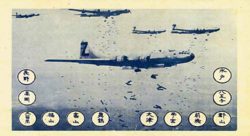
An example of a typical 20AF warning leaflet, over a million of this particular design were dropped over Japan on 1 August 1945. It reads:
Read this carefully as it may save your life or the life of a relative or a friend. In the next few days, some or all of the cities named on the reverse side will be destroyed by American bombs. These cities contain military installations and workshops or factories, which produce military goods. We are determined to destroy all of the tools of the military clique that they are using to prolong this useless war. Unfortunately, bombs have no eyes. So, in accordance with America's well-known humanitarian policies, the American Air Force, which does not wish to injure innocent people, now gives you warning to evacuate the cities named and save your lives.
America is not fighting the Japanese people but is fighting the military clique, which has enslaved the Japanese people. The peace, which America will bring, will free the people from the oppression of the Japanese military clique and mean the emergence of a new and better Japan.
You can restore peace by demanding new and better leaders who will end the War.
We cannot promise that only these cities will be among those attacked, but some or all of them will be, so heed this warning and evacuate these cities immediately.
6 August 1945
As per Operation CENTERBOARD, the Boeing B-29 Enola Gay (44-
The use of nuclear weapons against Japan remains controversial, largely due to ignorance and a willingness to apply modern values toward a foreign time and situation. As such, the controversy has overshadowed the actual event. This is why the Enola Gay, displayed at the National Air and Space Museum Steven F. Udvar-Hazy Center in Chantilly, VA in 2003, remains subject to constant threats of vandalism.
Since Little Boy is an experimental, gun-type nuclear weapon, the casing on the bomb is significantly smaller than that of Fat Man, which uses the same implosion system used on Gadget. The bomb is left unpainted aside from identification markings and signatures from base personnel. Among these signatures is a dedication to the crew of the USS Indianapolis (CA-35), the ship which had originally delivered the bomb to Tinian. The cruiser was torpedoed a week prior, killing all but 317 of its 1,196 crewmen, the vast majority dying from exposure, dehydration, and shark attack.
| Aircraft Type | Serial No. | Name | Code | Role |
| Boeing B-29-45-MO | 44-86292 | Enola Gay | 82 | Little Boy |
| Boeing B-29-40-MO | 44-27353 | Great Artiste | 89 | Instrument |
| Boeing B-29-45-MO | 44-86291 | Necessary Evil | 91 | Photo |
| Boeing B-29-40-MO | 44-27354 | Big Stink | 90 | Standby - Iwo Jima |
| Boeing B-29-35-MO | 44-27301 | Straight Flush | 85 | Recon - Hiroshima |
| Boeing B-29-35-MO | 44-27303 | Jabbitt III | 71 | Recon - Kokura |
| Boeing B-29-35-MO | 44-27298 | Full House | 83 | Recon - Nagasaki |
8 August 1945
The first Boeing B-29s of the US 8AF arrive at Kadena AFB on Okinawa. CG 8AF LTG Jimmy H. Doolittle was in theater since 16 July, formally establishing headquarters on 23 July. Doolittle's job is not easy. Veteran crews from the ETO resist transfer to the Pacific, stalling the already tedious process of transitioning to the B-29. The use of nuclear weapons against Japan mitigates this problem, and by the time the first 8AF units on Okinawa are ready for combat - the 333BG and 349BG - the war is already over. No 8AF operation is ever launched against Japan.
Later this night, Soviet Minister of Foreign Affairs Vyacheslav M. Molotov informs Japanese ambassador Naotake Satō that a state of war will exist between Japan and the USSR the following morning. Shortly after midnight, three army groups - the Transbaikal Front (Generál Ármii Rodion Y. Malinovsky), the 1st Far Eastern Front (Generál Ármii Kirill A. Meretskov), and the 2nd Far Eastern Front (Generál Ármii Maksim A. Purkayev) - under the overall command of Máršal Sovétskogo Sojúza Aleksandr M. Vasilevsky, invade Manchuria, Mongolia, Korea, the Kuril Islands, and the Karafuto Prefecture of Japan. The 38th Parallel of Korea ultimately becomes the zenith of this massive Soviet advance, and US forces are landed in Incheon on 8 September to ensure that it goes no further. This boundary will divide Korea into separate countries after the war, creating a communist north and a democratic south.
9 August 1945
As per Operation CENTERBOARD II, the Boeing B-29 Bock’s Car (44-27297, 509BG) drops a plutonium-based nuclear weapon, Fat Man, on the city of Nagasaki, Japan. Complications ensue on the strike when one of the support aircraft fails to reach the rendezvous point, causing the bomber to reach its original target, Kokura, too late for visual bombardment. Proceeding to their secondary target, Nagasaki, the bomber is dangerously forced to loiter – the mission was launched knowing that the reserve fuel system was inoperative – until a cloud break at the last minute permits the drop. The crew later diverts to Okinawa, running out of fuel on landing. Because of crew rotations, many sources incorrectly attribute the drop to another B-29 of the same unit: The Great Artiste (44-27353). Bock's Car is piloted by XO 509BG MAJ Chuck W. Sweeney, having traded aircraft with CPT Fred C. Bock to avoid moving equipment. (35,000 killed)
Unlike Little Boy, whose design was still experimental, Fat Man's design is thoroughly tested, quickly becoming the standard for all US fission-based nuclear weapons in the coming years. Her implosion system is virtually identical to that used on Gadget and her casing is the standard yellow "pumpkin" design previously used on 509BG practice sorties. Her weld-seams are painted black with a sealing agent and the casing is signed by base personnel, the most prominent signature being the acronym "JANCFU" in bold letters: "Joint Army-Navy-Civilian Fuck-Up."
Click here to see base personnel check the seals on Fat Man's casing.
A cabinet meeting, presided over by the Emperor Hirohito Shōwa, is held this night debating the increasingly important issue of surrender. Much discussion revolves around 1LT Marcus E. McDilda, whose North American P-51D, Gator (44-63901, 21FG), ditched off Japan's coast the previous day. Under interrogation, McDilda lied saying the US had "over 100 atomic bombs," convincing the Emperor to finally accept the terms of the Potsdam Declaration. Telegrams to neutral Switzerland are immediately made stating that Japan would surrender providing their monarchy remain in place. An official response by US Secretary of State James F. Byrnes on 12 August makes no concessions and reiterates the Potsdam terms.
The Boeing B-29 Bock’s Car is currently on display at the National Museum of the US Air Force in Dayton, OH.
| Aircraft Type | Serial No. | Name | Code | Role |
| Boeing B-29-35-MO | 44-27297 | Bock's Car | 77 | Fat Man |
| Boeing B-29-40-MO | 44-27353 | Great Artiste | 89 | Instrument |
| Boeing B-29-40-MO | 44-27354 | Big Stink | 90 | Photo |
| Boeing B-29-35-MO | 44-27298 | Full House | 83 | Standby - Iwo Jima |
| Boeing B-29-45-MO | 44-86292 | Enola Gay | 82 | Recon - Kokura |
| Boeing B-29-50-MO | 44-86347 | Laggin' Dragon | 95 | Recon - Nagasaki |
14 August 1945
The US 20AF launches 770 Boeing B-29s against the Naval Arsenal of Hikari, the Army Arsenal of Osaka, the marshalling yards of Marifu (Nishi-Iwakuni), and the Nippon Oil Refinery of Tsuchizaki (Akita), as well as firebombing the cities of Kumagaya and Isesaki, Japan. An additional 39 B-29s are deployed on mining operations. The bombers are led by CG 315BW BG Frank A. Armstrong, Jr. aboard Fluffy Fuz III and escorted by fighters of the US 7AF. The strike against Tsuchizaki holds the distinction of the longest operation launched from the Marianas, covering some 3,650 mi.
No bombers are lost and this is the last US air operation against Japan in the Second World War.
Realizing that he was on the brink of a military coup d'etat over his decision to surrender, Emperor of Japan Hirohito Shōwa records a message this night formally accepting all terms dictated by the Potsdam Declaration. Despite a failed coup attempt led by Shōsa Kenji Hatanaka placing the imperial palace on lockdown and killing two, the message is broadcast to the Japanese people the following day. It is the first time the people of Japan are physically addressed by their emperor. By doing so, the emperor unknowingly avoids a third nuclear strike scheduled against Kokura for 20 August 1945.
| Bombers Launched: | 809 |
| Bombers Effective: | 758 |
| Bombers Abort: | 51 |
| Abort Rate: | 7% |
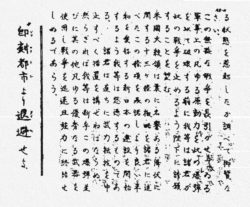
Leaflets, such as this one, featured images of mushroom clouds and were dropped in the weeks following the nuclear strikes on Hiroshima and Nagasaki. The fact that these were dropped after the bombings has led postwar critics to cite them as evidence the US had no intention of warning the Japanese of the atomic bombs, as if leaflets which did not specify bomb-type were not fair warning. This particular leaflet was dropped on 13 August, with some even falling over the imperial palace. It reads:
To the Japanese people:
America asks that you take immediate heed of what we say on this leaflet.
We are in possession of the most destructive explosive ever devised by man. A single one of our newly developed atomic bombs is actually the equivalent in explosive power to what 2,000 four giant B-29's can carry on a single mission. This awful fact is one for you to ponder and we solemnly assure you it is grimly accurate.
We have just begun to use this weapon against your homeland. If you still have any doubt, make inquiry as to what happened to Hiroshima when just one atomic bomb fell on that city.
Before using this bomb to destroy every resource of the military by which they are prolonging this useless war, we ask that you now petition the Emperor to end the war. Our President has outlined for you the thirteen consequences of an honorable surrender. We urge that you accept these consequences and begin the work of building a new, better, and peace-loving Japan.
You should take steps now to cease military resistance. Otherwise, we shall resolutely employ this bomb and all our other superior weapons to promptly and forcefully end the war.
Evacuate your cities.
Emperor Hirohito Shōwa's broadcast notably sidesteps the issue of the monarchy's continued existence and goes to great lengths to place the nation's wartime actions in a sympathetic light. When Japan is placed under occupation under GA Douglas MacArthur after the war, the emperor is absolved for his nation's actions. In doing so, MacArthur ensures that Hirohito's narrative remains enshrined amongst his people, with Japan to this day seeing itself as a victim of Western aggression despite its bloody legacy.
To our good and loyal subjects:
After pondering deeply the general trends of the world and the actual conditions obtaining in our empire today, we have decided to effect a settlement of the present situation by resorting to an extraordinary measure.
We have ordered our government to communicate to the governments of the United States, Great Britain, China, and the Soviet Union that our empire accepts the provisions of their joint declaration.
To strive for the common prosperity and happiness of all nations, as well as the security and well-being of our subjects, is the solemn obligation which has been handed down by our imperial ancestors and which lies close to our heart.
Indeed, we declared war on America and Britain out of our sincere desire to ensure Japan's self-preservation and the stabilization of East Asia, it being far from our thought either to infringe upon the sovereignty of other nations or to embark upon territorial aggrandizement.
But now the war has lasted for nearly four years. Despite the best that has been done by everyone – the gallant fighting of the military and naval forces, the diligence and assiduity of our servants of the state, and the devoted service of our one hundred million people – the war situation has developed not necessarily to Japan's advantage, while the general trends of the world have all turned against her interest.
Moreover, the enemy has begun to employ a new and most cruel bomb, the power of which to do damage is, indeed, incalculable, taking the toll of many innocent lives. Should we continue to fight, not only would it result in an ultimate collapse and obliteration of the Japanese nation, but also it would lead to the total extinction of human civilization.
Such being the case, how are we to save the millions of our subjects, or to atone ourselves before the hallowed spirits of our imperial ancestors? This is the reason why we have ordered the acceptance of the provisions of the joint declaration of the powers.
We cannot but express the deepest sense of regret to our allied nations of East Asia, who have consistently cooperated with the Empire towards the emancipation of East Asia.
The thought of those officers and men as well as others who have fallen in the fields of battle, those who died at their posts of duty, or those who met with untimely death and all their bereaved families, pains our heart night and day.
The welfare of the wounded and the war-sufferers, and of those who have lost their homes and livelihood, are the objects of our profound solicitude.
The hardships and sufferings to which our nation is to be subjected hereafter will be certainly great. We are keenly aware of the inmost feelings of all of you, our subjects. However, it is according to the dictates of time and fate that we have resolved to pave the way for a grand peace for all the generations to come by enduring the unendurable and suffering what is unsufferable.
Having been able to safeguard and maintain the kokutai [Imperial system], we are always with you, our good and loyal subjects, relying upon your sincerity and integrity.
Beware most strictly of any outbursts of emotion which may engender needless complications, or any fraternal contention and strife which may create confusion, lead you astray and cause you to lose the confidence of the world.
Let the entire nation continue as one family from generation to generation, ever firm in its faith in the imperishability of its sacred land, and mindful of its heavy burden of responsibility, and of the long road before it.
Unite your total strength, to be devoted to construction for the future. Cultivate the ways of rectitude, foster nobility of spirit, and work with resolution – so that you may enhance the innate glory of the imperial state and keep pace with the progress of the world.
18 August 1945
Two US 5AF Consolidated B-32s out of Okinawa are attacked by 14 A6M Zeros and three N1K Georges while on a reconnaissance flight over Tokyo, Japan. This is the second incident this week where B-32s are attacked despite the surrender declaration. Their intransigence made clear, particularly through by taunting US bombers, the US demands that Japanese airbases remove the propellers from their operational aircraft. Among the wounded airmen is 19 year-old photographer's assistant SSGT Anthony J. Marchione, flying aboard the B-32A Hobo Queen II (42-108532, 312BG). Like her Boeing B-29 cousin - Hobo Queen (41-36963) - Hobo Queen II was originally used to tour US bases so as to familiarize airmen with the new bomber. Now transferred to combat duty, Hobo Queen II's legacy becomes far more somber:
Marchinoe dies from his wounds on the long flight home and is the last American airman to die in the Second World War.
29 August 1945
Boeing B-29 Hog Wild (44-70136, 500BG) is shot down by Soviet Yak-9s while attempting to drop supplies to Allied POWs near Hŭngnam, Korea. Following an earlier two-ship sortie, Hog Wild was unable to locate the POW camp and was intercepted by Soviet Yaks for suspiciously circling the area. Unable to comply with gestured demands to land (the runway in question was too short), the bomber turned for the Sea of Japan when it was fired on. Half of the crew bails out over the water while the other half attempts to crashland in Korea. A formal protest from CG AFPAC GA Douglas MacArthur sees to the release of Hog Wild’s crew who, despite stringent interrogation, suffer no casualties.
The loss of Hog Wild remains a fixture of conspiracy theories to this day. This is based on the belief that Hog Wild was not intended for humanitarian relief but was photographing the Chōsen Chisso Hiryō (Korean Nitrogenous Fertilizer) complex. The fact that this complex is later used to produce radioactive material for the Soviet Union is often used to justify this reconnaissance conspiracy. This is unlikely. Reconnaissance aircraft typically carried up to six cameras whereas Hog Wild carried only a standard-issue strike camera. Regardless, Soviet aggression, against what was clearly an Allied aircraft, does not go unnoticed as an incident in the ever-developing Cold War.
2 September 1945
The Second World War's Pacific Theater of Operations comes to a close after 13 years, 11 months, and 16 days. Under the authorization of Emperor Hirohito Showa, Japan formally surrenders to Allied forces through Gaimu Daijin (Minister of Foreign Affairs) Mamoru Shigemitsu and Taishō Yoshijirō Umezu aboard the USS Missouri (BB-63), anchored in Tokyo Bay. Thus ends the bloodiest conflict in human history. Approximately 70 million people lost their lives in the conflict, with some 25 million dying in military service and another 14 million under the genocidal efforts of the German, Japanese, and Soviet governments. The true and exact figures may never be known.
Click here to read the Japanese Instrument of Surrender.
Pres. Harry S Truman (D-MO) actively worked against allowing the Soviet Union to gain a foothold in Japan akin to Eastern Europe, going so far as to tell Premier Joseph V. J. Stalin as much. Not content with this arrangement, Stalin's representative aboard the Missouri, Generál-Lejtenánt Kuzma N. Derevyanko is instructed to push MacArthur toward dividing Japan into zones-of-occupation, a la Germany, and to obtain intelligence on the effects of the Little Boy and Fat Man nuclear weapons. MacArthur flatly refuses this request, and while Derevyanko spends a great deal of time in Hiroshima and Nagasaki, he later dies of radiation poisoning in 1954 at the age of 50.

